Rules and informations about games.
This is the multi-page printable view of this section. Click here to print.
Games
- 1: Amazons
- 2: Breakthrough
- 3: Catchup
- 4: Chess
- 5: Conhex
- 6: Oceans 11
- 7: Connect6
- 8: Dots and boxes
- 9: Draughts
- 10: Dvonn
- 11: EinStein würfelt nicht!
- 12: Fendo
- 13: Four in a row
- 14: Gomoku
- 15: Go
- 16: Golem word game
- 17: Havannah
- 18: Hex
- 19: Line of Action
- 20: Lyngk
- 21: Morreli
- 22: Oski
- 23: Polyomino
- 24: QYPS
- 25: Reversi
- 26: Tumbleweed
- 27: Shogi
- 28: Slither
- 29: Street soccer
- 30: Twixt
- 31: Tzaar
- 32: WYPS
- 33: XiangQi
1 - Amazons
Rules
White moves first, and the players alternate moves thereafter. Each move consists of two parts. First, one moves one of one’s own amazons one or more empty squares in a straight line (orthogonally or diagonally), exactly as a queen moves in chess; it may not cross or enter a square occupied by an amazon of either color or an arrow. Second, after moving, the amazon shoots an arrow from its landing square to another square, using another queenlike move. This arrow may travel in any orthogonal or diagonal direction (even backwards along the same path the amazon just traveled, into or across the starting square if desired). An arrow, like an amazon, cannot cross or enter a square where another arrow has landed or an amazon of either color stands. The square where the arrow lands is marked to show that it can no longer be used. The last player to be able to make a move wins. Draws are impossible.
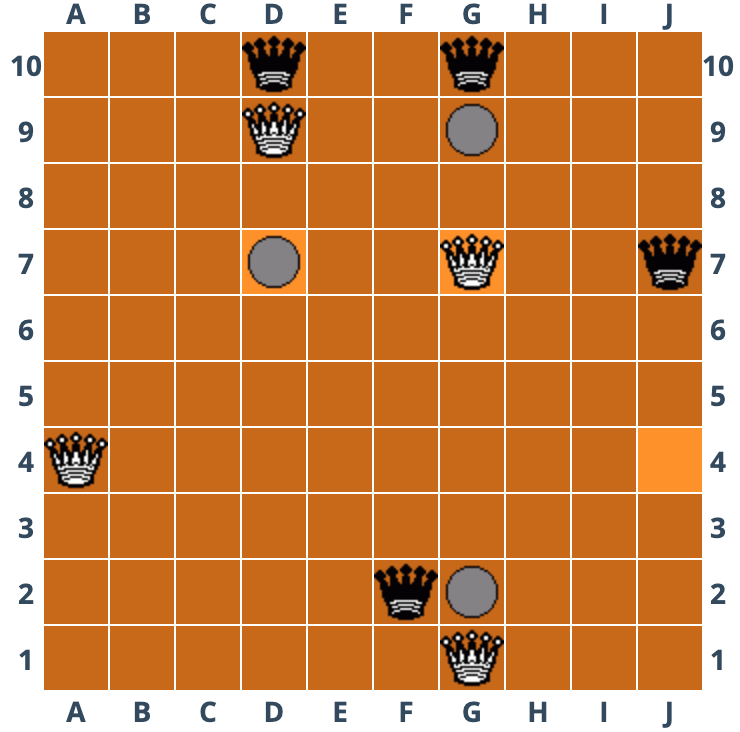
Variants
Two variants are played on LittleGolem. The standard game and Cross Variant, where the starting position is different.
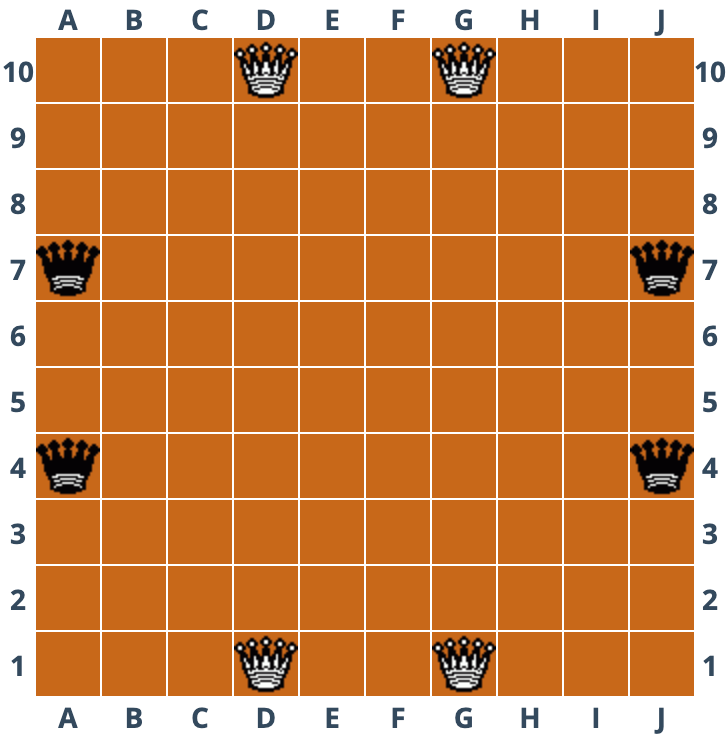
Links
- Wikipedia - Rules, history
- Board Game Geek
2 - Breakthrough
Rules
Breakthrough was originally played on a 7×7 board with 14 pieces per player; however, since it won the 2001 8×8 Game Design Competition sponsored by the Abstract Games Magazine and the Strategy Gaming Society, the 8×8 version with 16 pieces per player is considered standard. Advanced players might enjoy the more complex 10×10 version with 30 pieces per player. The standard game starts with the first two rows in front of each player filled with his pieces (see the figure). Players alternate moving one of their own pieces per turn, trying to reach the opposite side of the board. The first player to do so will be declared the winner.

A piece can move forward or diagonally forward to an adjacent empty cell. Alternatively, it can capture an enemy piece diagonally forward (as chess pawns do). Captures are neither compulsory nor can be chained. In the figure, piece 1 can move freely, whereas piece 2 has two of their three possible moves blocked by friendly pieces. Piece 3 can move directly forward or capture any of the enemy pieces, whereas piece 4 can capture or move diagonally but is unable to move forward. Note that White’s pieces move and capture in the opposite direction.
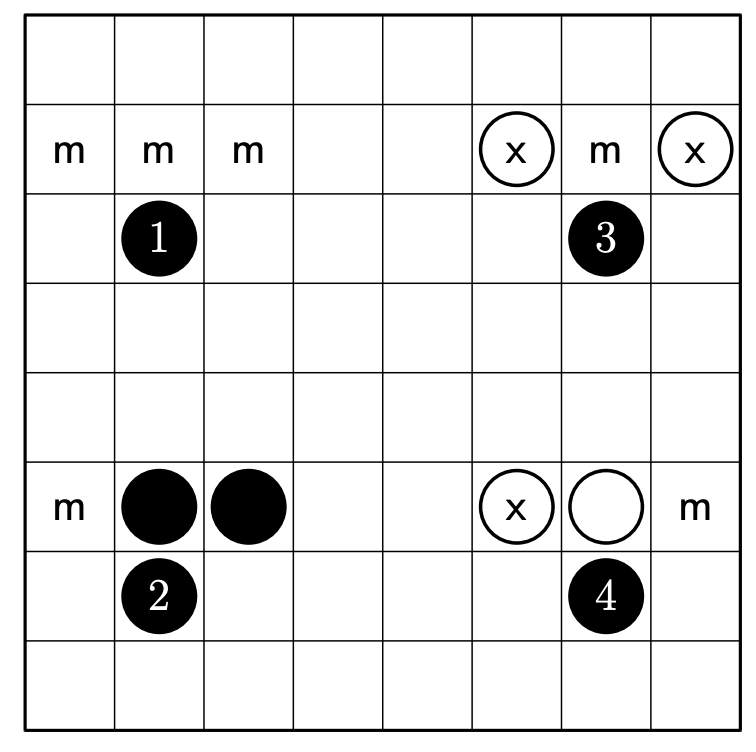
Links
- Basic Introduction - Great indroduction (6 page) to game by Carlos Luna-Mota. (github link)
- Board Game Geek
- Wikipedia
3 - Catchup
Catchup is a simple abstract game with a devilish dynamic. The goal is to have the largest group of stones on the board when the board is full of stones, but as you get closer to winning, your opponent gets more powerful. Whereas most stone-placement games are about position, Catchup is about timing, position, and the interplay between them.
Definitions:
-
Group – a set of connected, like-colored stones on the board. A single stone is also considered a group.
-
Score - your score is the number of stones contained in your largest group. At the beginning of the game, both players’ scores are set to 1
Rules:
-
One player owns the white stones and the other owns the black. White begins by placing 1 stone on any empty space.
-
From then on, starting with black, players take turns. On your turn, you may place 1 or 2 stones, or up to 3 if your opponent’s score increased on their last turn and is, at the beginning of your turn, greater than or equal to your score.
-
After taking your turn, if your score has changed, move your pawn to the corresponding spot on the scoring track.
-
The game ends when the board is full. The player with the largest group wins. If the players’ largest groups are the same size, compare their second-largest groups, and so on, until you come to a pair which aren’t the same size. Whoever owns the larger of the two wins.
Variants
Three variants with different board are played on Little Golem.
Standard game on size 5
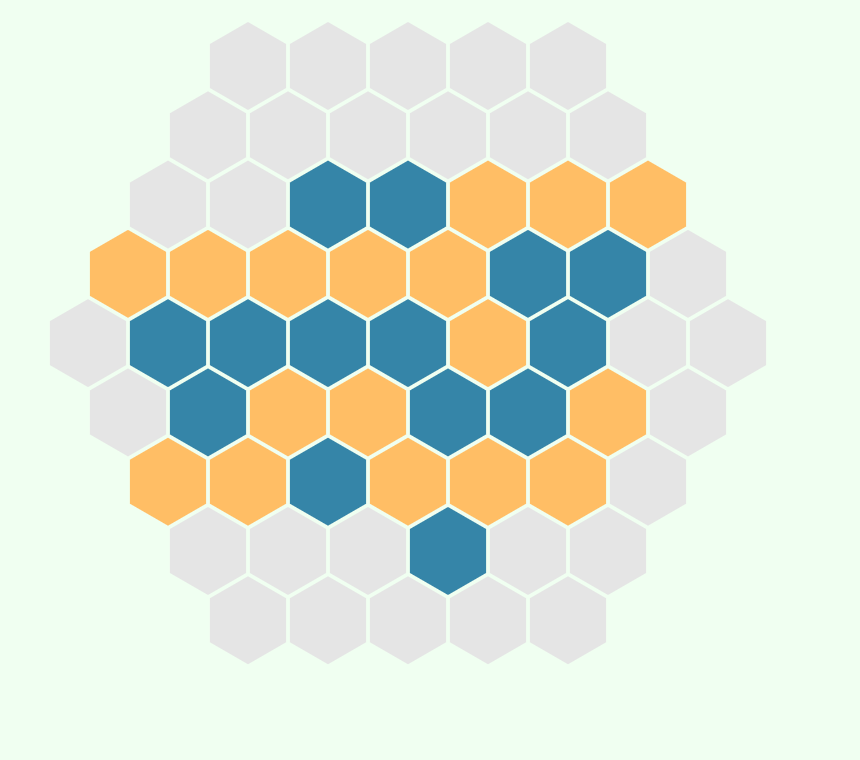
Game on random board
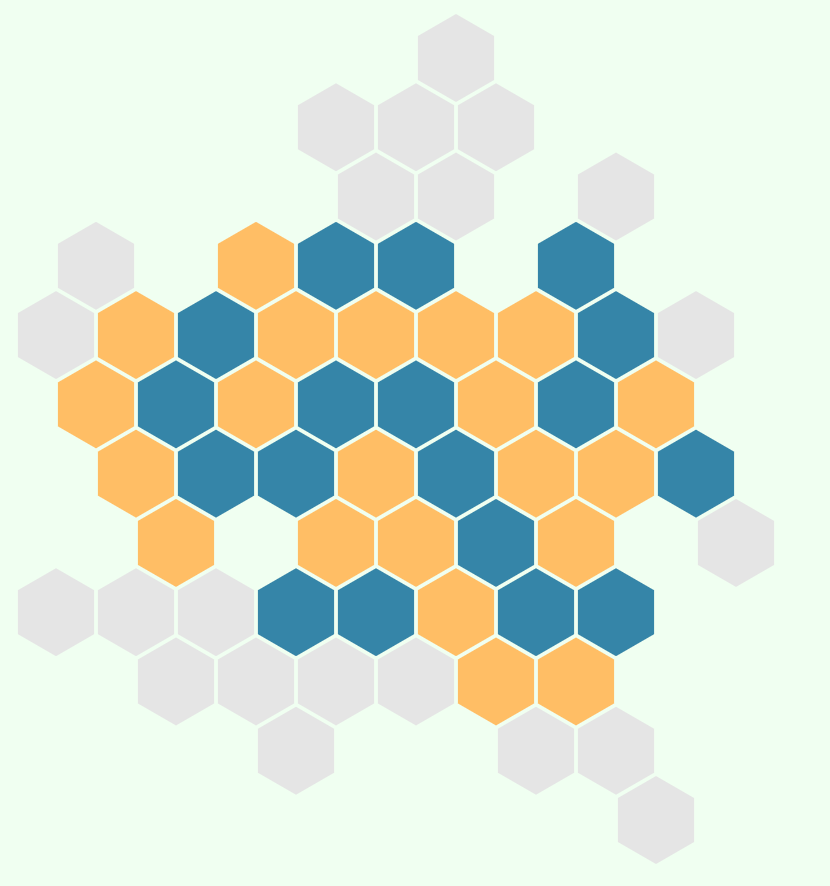
Game on on size 7
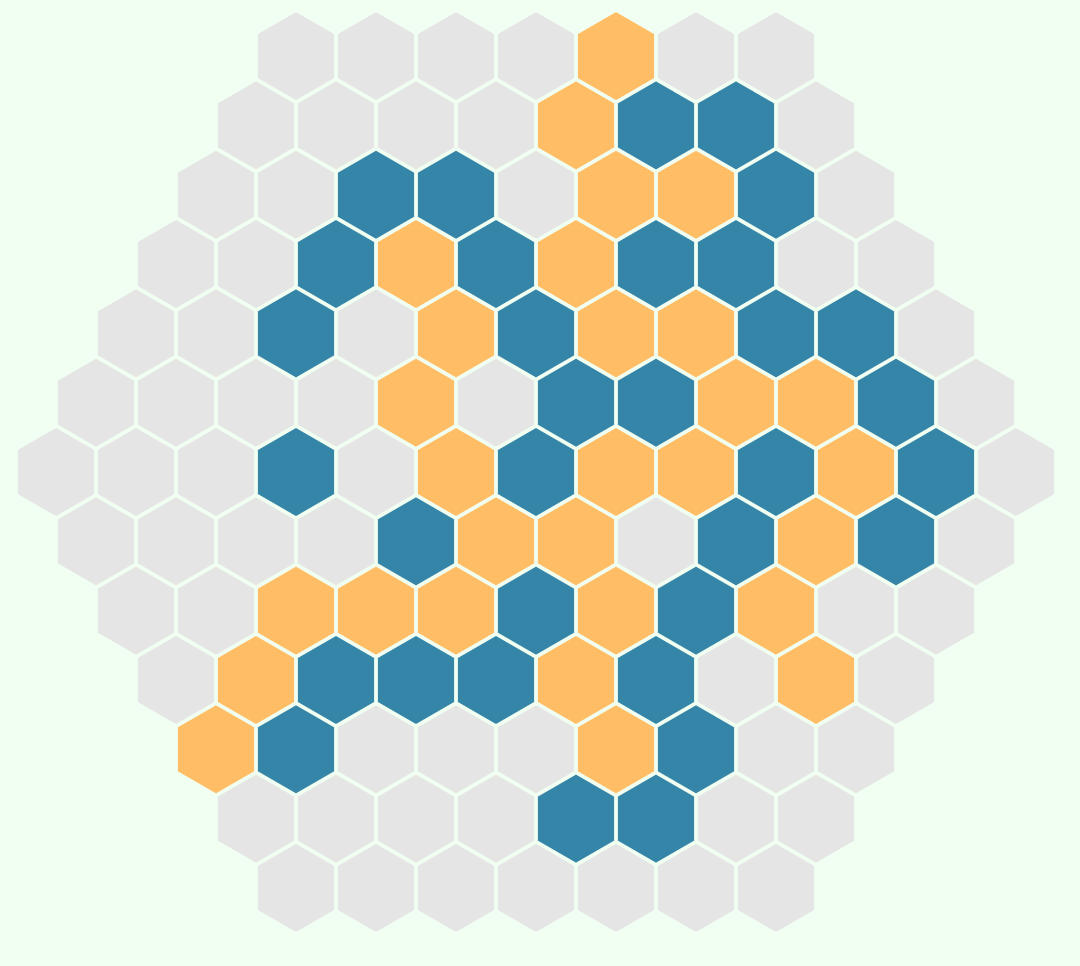
Links
- Article by Nick Bentley - rules, a lot of links, print-and-play,
- Board Game Geek
4 - Chess
Chess is classic board game. Probably the most popular board game in the world, at least in Europe and in America.
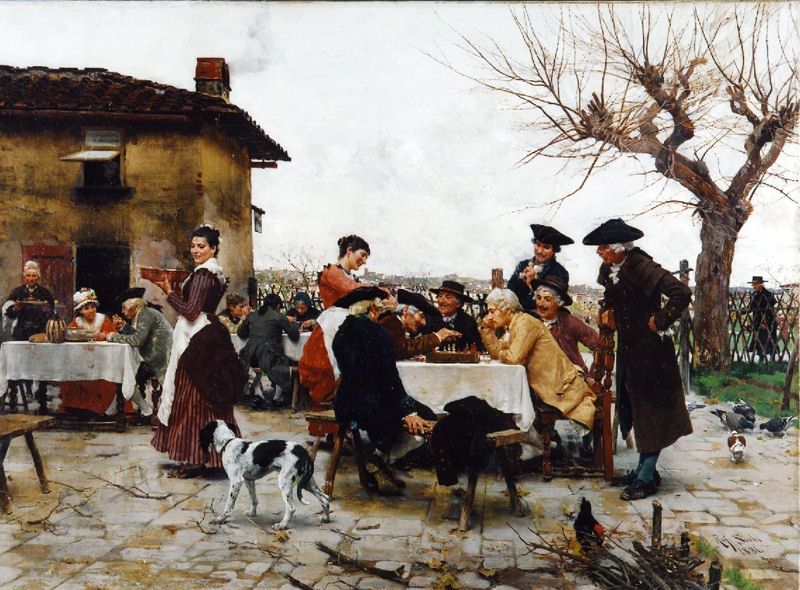 Raffaello Sorbi - La partita a scacchi/Chess game
Raffaello Sorbi - La partita a scacchi/Chess game
Rules
The rules of chess are on a lot of places:
- wikipedia.org chess
- wikipedia.org chess rules
- FIDE - International Chess Federation
- chess.com animated and videos
Variant - Chess960
Chess960 is also known as Fisher random chess or Chess9LX. Chess960 employs the same board and pieces as classical chess, but the starting position of the pieces on the players’ home ranks is randomized, following certain rules. The random setup makes gaining an advantage through the memorization of openings impracticable; players instead must rely more on their talent and creativity over the board.
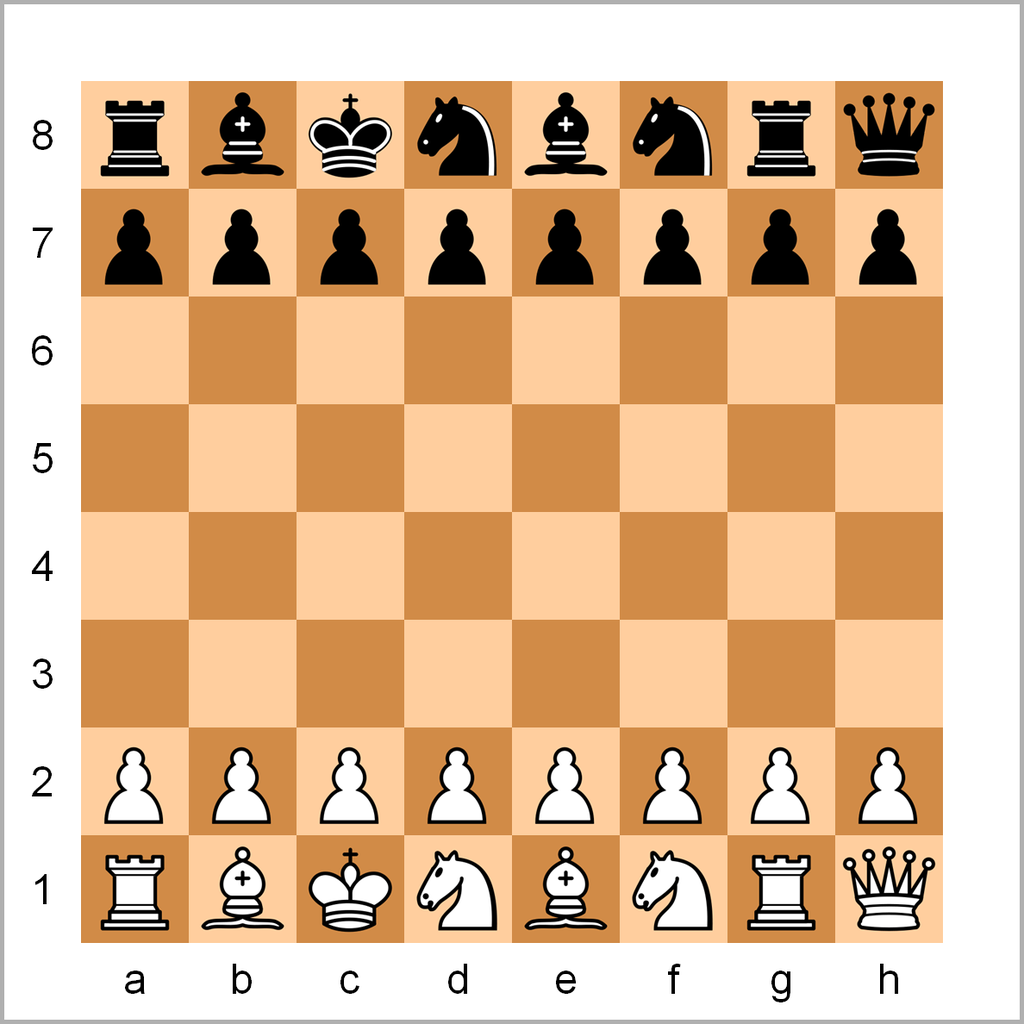
More on wikipedia
Variant - Crazyhouse
Crazyhouse is a popular chess variant similar to bughouse, but you only need two players to play. The basic premise of crazyhouse is that pieces which you capture from your opponent can be dropped on empty squares on your turn.
More on wikipedia
Variant - Grand Chess
Grand Chess is a large-board chess variant invented by Dutch games designer Christian Freeling in 1984. GM Larry Kaufman has written that Grand Chess “really is an excellent game and deserves a bigger following”.

It is best to read about Grand Chess directly on the author’s website: www.mindsports.nl
Variant - Seirawan Chess
Seirawan Chess was invented by GM Yasser Seirawan and Bruce Harper. In Seirawan Chess (S-chess) the rules are the same as in orthodox chess, except that two pieces, the Elephant and the Hawk, are placed in the reserve. The Elephant (Chancellor) combines the powers of a Rook and a Knight. It is comparable in strength to the Queen. The Hawk (Cardinal) combines the powers of a Bishop and a Knight. It is somewhat weaker than a Queen. These pieces are known from Capablanca’s Chess.
Whenever a piece leaves its initial square, one of the extra pieces can immediately be introduced to the vacant square. So this is a double move, comparable to castling. Should a player refrain from inserting his extra pieces at these occasions, then he has forfeited his chance of introducing them. When castling, one of the extra pieces can be placed on either of the squares left vacant, namely the corner square, or the e1/e8 square. Pawns can, additionally, promote to Elephant or Hawk.
5 - Conhex
Conhex is a 2-player abstract game in which the winner is the first player to connect his or her assigned sides of a square board (thus the goal is similar to the goal in Twixt.) The board is a pattern of non-regular hexagons with a few non-hexagonal polygons. Players alternate turns placing pieces of their own color on a vertex, and a player can claim a space after placing pieces on at least half the vertices of that space.

Links
6 - Oceans 11
Rules (from pagat.com)
Introduction
A two player game using poker hands. Instead of betting players have to decide how to deploy their 54 cards to win the best of 11 poker hands.
The Deck(s)
Two standard international 54-card (52 cards and 2 jokers) decks (one for each player).
Cards have their usual ranking as in Poker.
Object of the Game
Be the first player to win 6 hands of poker.
Play
To start, each player shuffles their individual deck, and flips the top card face up.
These cards form the start of each player’s poker hand, and are compared.
Each time a card is revealed, the up-cards are compared to see which player has the stronger poker hand.
The player with the weaker hand must choose between two options:
- Deal another card from their deck and add it to the row of face-up cards in front of them, to try to improve their poker hand.
- Concede the hand to the other player.
If a player deals another card, the rows of up-cards are again compared to see which player is weaker, and the lower hand again has the same options as above.
If the two players have equally high hands, both must deal an additional card face-up.
This continues until one of the players concedes. All the face-up cards are then discarded, and will not re-enter play. Normal practice is for the player who won the hand (did not concede) to place one of the used cards apart from their discard pile, to keep track of the number of hands won. Each player then deals the next card of their deck face up to start the next hand.
There is no limit to the number of cards the player with the weaker hand may expose in an effort to win the hand, except that a player who runs out of cards is forced to concede, having no more cards to deal.
Comparing Hands
When comparing hands, each player makes their best five-card poker hand from the row of cards in front of them. If there are fewer than five cards, the hand is ranked as though the remaining cards are worthless non-matching cards with no rank and no suit.
End of the Game
The first player to win 6 hands is the winner of the game.
It follows that once a player is at 5 wins, their opponent cannot concede a hand early unless they run out of cards. When a player runs out of cards, their opponent wins the current hand and then can win additional hands by simply playing one card from their stock, as long as their stock persists. If both players run out of cards, the player with the most wins is the champion.
If they win an equal number of hands, the game is a draw.
Variants
On LittleGolem, the basic variant is played with 2 wild cards (jokers). Other possible variants are:
- play without wild cards (52 card deck)
- deuces are also wild cards
- play with 65 cards (5 suits) for 13 hands instead of 11
- mini version where everyone has half a deck of cards (26) for 5 games or 27 cards (one joker in deck).
Links
- Pagat - Rules, Info
- Board Game Geek
7 - Connect6
Rules
The rules of Connect6 are very simple and similar to the traditional game of Gomoku:
- Players and stones: There are two players. Black plays first, and White second. Each player plays with an appropriate color of stones, as in Go and Gomoku.
- Game board: Connect6 is played on a square board made up of orthogonal lines, with each intersection capable of holding one stone. In theory, the game board can be any finite size from 1×1 up (integers only), or it could be of infinite size. However, boards that are too small may lack strategy (boards smaller than 6×6 are automatic draws), and extremely large or infinite boards are of little practical use. 19×19 Go boards might be the most convenient. For a longer and more challenging game, another suggested size is 59×59, or nine Go boards tiled in a larger square (using the join lines between the boards as additional grid lines).
- Game moves: Black plays first, putting one black stone on one intersection. Subsequently, White and Black take turns, placing two stones on two different unoccupied spaces each turn.
- Winner: The player who is the first to get six or more stones in a row (horizontally, vertically, or diagonally) wins. (This is a departure from Gomoku, where it must be exactly five in a row.)
According to Professor Wu, the handicap of black’s only being able to play one stone on the first turn means that the game is comparatively fair; unlike similar games such as Gomoku and Connect Four, which have been proven to give the first player a large advantage, possibly no additional compensation is necessary to make the game fair.

Links
- Wikipedia - Rules, History
- Board Game Geek
8 - Dots and boxes
Rules
Each player must alternately draw dashes joining adjacent vertical or horizontal dots. If you are able to complete a square, you mark it as your own and you must draw another dash. At the end of the game, players achieve long runs of squares. When all squares are claimed, the game ends, and the winner is the player with the most squares.

Variants
On Little Golem is game played on boards: 4x4, 5x5, 6x6 and 7x7.
Links
- Wikipedia
- The Dots and Boxes Game: Sophisticated Child’s Play - book by Elwyn R. Berlekamp
9 - Draughts
 Gustave Courbet The Draughts Players 1844
Gustave Courbet The Draughts Players 1844
Variants
On Little Golem is played several variants.
English Draughts
English draughts (British English) or checkers (American English; see spelling differences), also called American checkers or straight checkers, is a form of the strategy board game draughts. It is played on an 8×8 chequered board with 12 pieces per side. The pieces move and capture diagonally forward, until they reach the opposite end of the board, when they are crowned and can thereafter move and capture both backward and forward.
As in all forms of draughts, English draughts is played by two opponents, alternating turns on opposite sides of the board. The pieces are traditionally black, red, or white. Enemy pieces are captured by jumping over them.
Links
- Wikipedia
- WCDF - World Checkers and Draughts federation
- Board Game Geek
International draughts
International draughts (also called Polish draughts or international checkers) is a strategy board game for two players, one of the variants of draughts. The gameboard comprises 10×10 squares in alternating dark and light colours, of which only the 50 dark squares are used. Each player has 20 pieces, light for one player and dark for the other, at opposite sides of the board. In conventional diagrams, the board is displayed with the light pieces at the bottom; in this orientation, the lower-left corner square must be dark.
Links
- Wikipedia
- Board Game Geek
- FMJD - World Draughts Federation
Dameo
Dameo is an abstract strategy board game for two players invented by Christian Freeling in 2000. It is a variant of the game draughts (or checkers) and is played on an 8×8 checkered gameboard.
Dameo is played on an 8×8 checkerboard with 18 pieces per player. Each player’s pieces are arranged so that the bottom three rows, from the perspective of the player, are filled from a1 to h1, b2 to g2, and c3 to f3, forming a distinctive trapezoid shape.
- The player with the lighter pieces moves first. Then turns alternate.
- The pieces, called men, can only move forward, either straight ahead or diagonally.
- In addition, men can jump over one or more other subsequent men of the same color in a straight line forward or diagonally, provided that the square ahead of the line is free.
- When a man reaches the last row of the opposite side of the board, it is crowned, or promoted, to a king. The king can move in 8 directions to any available number of cells, like a queen in chess. King promotion is powerful and greatly benefits the player who accomplishes it.[4][5]
- Capturing involves jumping over enemy pieces and removing them from the board. All captures in Dameo are orthogonal only. A man may capture forwards, backwards and sideways by a short leap to an unoccupied space one square directly beyond the captured piece. If a jump is possible it must be done, even if doing so incurs a disadvantage.
- A king may capture by a long leap to any unoccupied square opposite the captured piece, so long as there is no other piece obstructing the path of the king.
- Multiple successive captures in a single turn must be made if, after each jump, there is an unoccupied square immediately beyond the enemy piece. One must play with the piece that can make the maximum number of captures.
- A jumped piece is removed from the board at the end of the turn. For a multi-jump move, captured pieces are not removed during the move; they are removed only after the entire multi-jump move is complete.
- The same piece may not be jumped more than once. A player with no valid move remaining loses. This occurs if the player has no pieces left, or if all the player’s pieces are obstructed from moving by opponent pieces.
- A game is a draw if neither player can win the game.
- A game is considered a draw when the same position repeats three times by the same player (not necessarily consecutively).[6]
- Dameo has very few draws. Dameo’s draw margin at high level play is estimated to be around 21%
Links
10 - Dvonn

DVONN is a two-player strategy board game in which the objective is to accumulate pieces in stacks. It was released in 2001 by Kris Burm as the fourth game of the GIPF Project. DVONN won the 2002 International Gamers Award and the Games magazine Game of the Year Award in 2003.
Rules
Links
11 - EinStein würfelt nicht!
The name of the game in German has a double meaning. It is a play on Einstein’s famous quote “I am convinced that He (God) does not play dice” and also refers to the fact that when a player has only one cube (ein Stein) remaining, they no longer need to “play dice”, and may simply move the cube.
Rules
The game is played on a square board with a 5×5 grid. Each player has six cubes, numbered one to six. During setup, players arranges the cubes within the triangular area of their own color.
The players take turns rolling a six-sided die and then moving the matching cube. If the matching cube is no longer on the board, the player moves a remaining cube whose number is next-higher or next-lower to the rolled number. The player starting in the top-left may move that cube one square to the right, down, or on the diagonal down and to the right; the player starting in the bottom-right may move that cube one square to the left, up, or on the diagonal up and to the left. Any cube which already lies in the target square is removed from the board.
The objective of the game is for a player to either get one of their cubes to the far corner square in the grid (where their opponent started) or to remove all of their opponent’s cubes from the board.
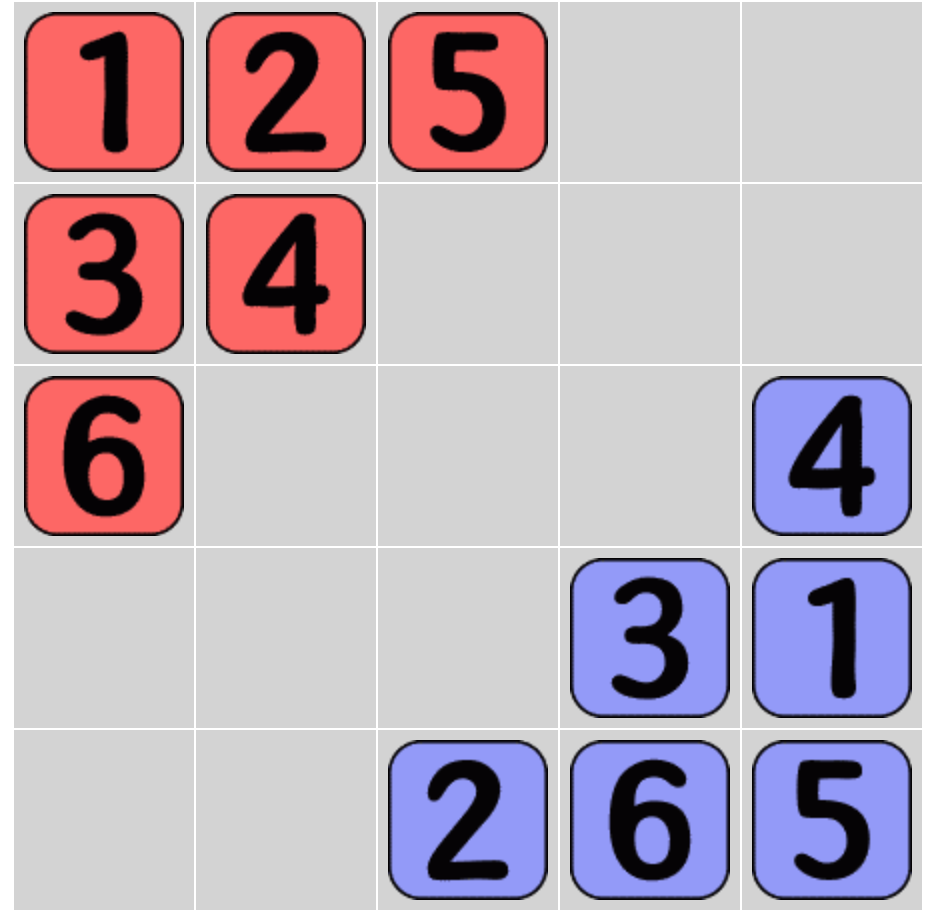
Variants
On Little Golem are played 7 variants according to lenght of match: 1,3,5,7,11,19,50 points match.
Blackhole variant has black hole in middle of board, where stone is lost. Game is played as 3 points match.
Backwards capture variant allow backward capture move. Game is played as 3 points match.
Links
12 - Fendo
Information
Fendo is probably Dieter Stein’s best board game. It meets exactly all the prerequisites for a perfect abstract game: very simple rules, deep strategy and tactics. In addition, there is no possibility of a draw in the game. The game is also very nicely aesthetically made of wood.
Links
All information and rules are on the official website.
13 - Four in a row

Four in a row is two-player connection board game, in which the players choose a color and then take turns dropping colored discs into a seven-column, six-row vertically suspended grid. The pieces fall straight down, occupying the lowest available space within the column. The objective of the game is to be the first to form a horizontal, vertical, or diagonal line of four of one’s own discs.
Variants
Game on Little Golem is played on four board sizes: 6x7 (classic), 8x8, 9x9, 10x10
Links
14 - Gomoku
Gomoku, also called Five in a Row, is an abstract strategy board game. It is traditionally played with Go pieces (black and white stones) on a Go board. Because pieces are typically not moved or removed from the board, gomoku may also be played as a paper-and-pencil game. The game is known in several countries under different names.
Rules
Players alternate turns placing a stone of their color on an empty intersection. Black plays first. The winner is the first player to form an unbroken chain of five stones horizontally, vertically, or diagonally.
Variants
Gomoku
- The player who places 6 or more checkers on the line wins.
- The first move of the black player is always in the center of the board.
- The second black move is played outside the marked region.
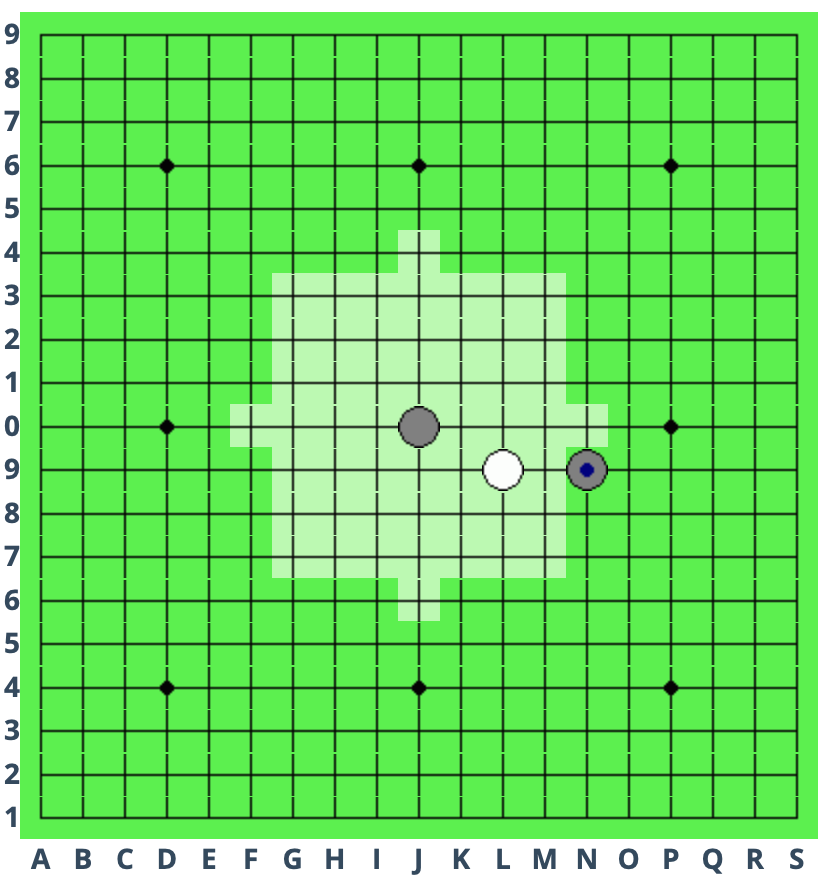
Gomoku Pro
- The game is played on a 15x15 board.
- The first player places 1,2,3,4 or 5 pieces on the board.
- The second player switches sides or continues the game.
- There is no draw. The first player, who has no theoretical chance to win, has lost the game.

Gomoku Pro 9x9
Version of gomoku pro played on 9x9. In the picture black is the winner.

Links
15 - Go
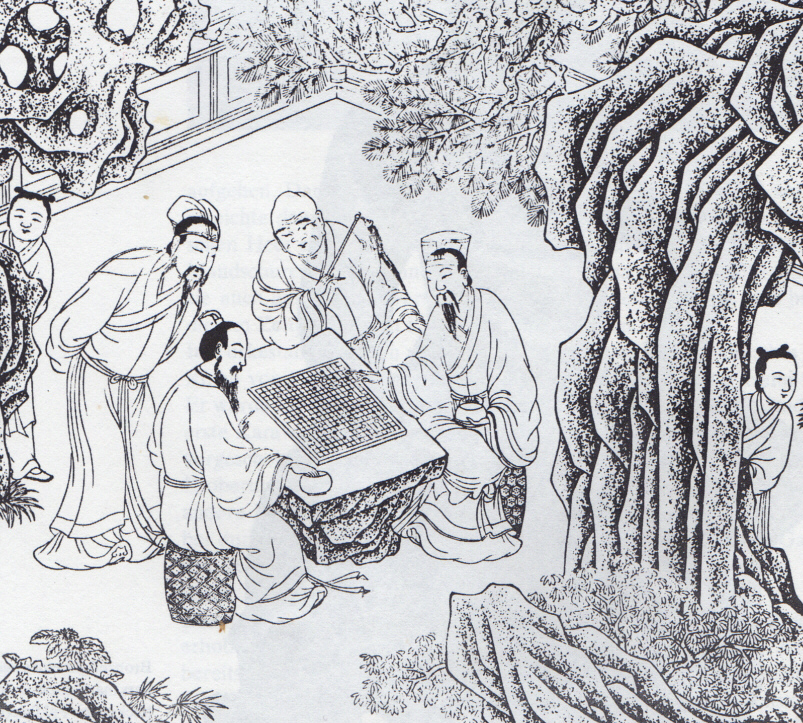
Rules
The playing pieces are called stones. One player uses the white stones and the other, black. The players take turns placing the stones on the vacant intersections (points) of a board. Once placed on the board, stones may not be moved, but stones are removed from the board if the stone (or group of stones) is surrounded by opposing stones on all orthogonally-adjacent points, in which case the stone is captured.[4] The game proceeds until neither player wishes to make another move. When a game concludes, the winner is determined by counting each player’s surrounded territory along with captured stones and komi (points added to the score of the player with the white stones as compensation for playing second).[5] Games may also be terminated by resignation.
Go has simple rules but is extremely complex.
Rules of Go on Wikipedia.
Variants on Little Golem
Sizes 9x9, 13x13, 19x19, 37x37
There are four different board sizes.
Hahn Pointing System
The Hahn Pointing System is a new method to determine the tournament winner using points earned as a result of each game in place of the players win/loss record. Professor Sang-Dae Hahn of Myongji University developed the system to foster aggressive, fighting games with an emphasis on reading.
The Hahn system is based upon the scoring used in bangneki. Points are awarded to the winner and the loser of the game based upon the result. A single game is worth 100 points. The 100 points are divided between the winner and the loser based upon the difference in count at the end of the game.
A difference of 0.5 to 10 in the count results in the winner receiving 60 points and the loser receiving 40 points.
A difference of 10.5 to 20 in the count results in the winner receiving 70 points and the loser receiving 30 points.
A difference of 20.5 to 30 in the count results in the winner receiving 80 points and the loser receiving 20 points.
A difference of 30.5 to 40 in the count results in the winner receiving 90 points and the loser receiving 10 points.
A difference of more than 40 points results in the winner receiving all 100 points and the loser receiving no points.
The tournament winner in a Hahn pointing system scored tournament is the player with the most points, regardless of the player’s win/loss record in the tournament. Therefore, a player with 580 points and a win/loss record of 5-2 beats a player with 570 points and a perfect win/losss record of 7-0.
Random board
Players play from a position, where there are already 100 stones on the board. The positions have been checked for equality by the computer.
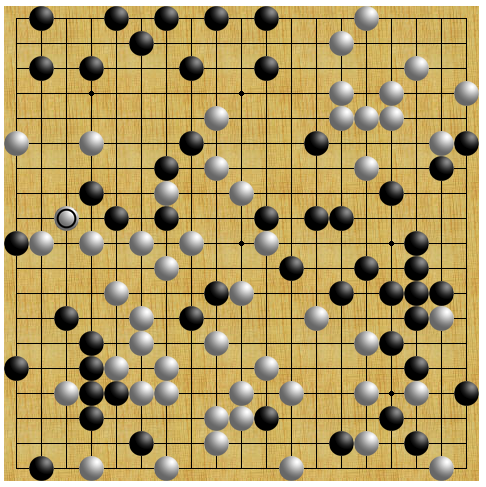
Toroidal go
Game go 11x11 is played on toroid.

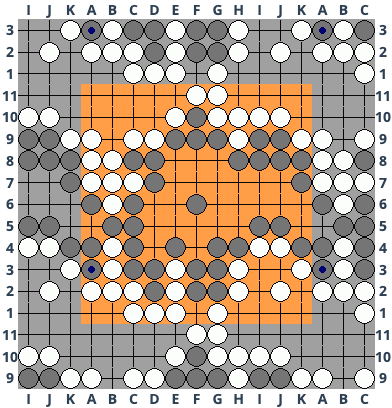
Links
- Wikipedia
- SenSei Library - site with 23000 pages about Go
- Go Books on iPad
16 - Golem word game
Rules
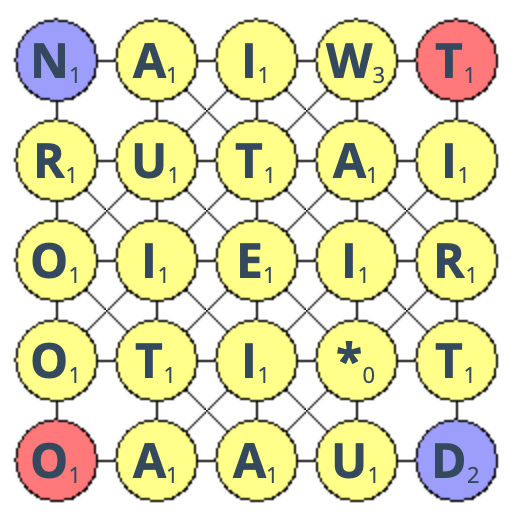
Golem’s word game is word game for two players. Target of game is finding words on board. Each player takes out tiles from board and these tiles are replaced by other tiles from bag. Order of tiles in bag is known. Players score according to the rules. Player with higher score at the end of game is winner. Game has three parts:
1. Auction, bidding
Player, who wants to have first move in game, must offer points for second player. Who offers more points, will start game. This happens, because first player can have decisive advantage.
2. Middle game
Player must create proper English word or choose only one tile. Players get points for chosen tiles. These tiles are replaced from board and another tiles from bug are put on the board. Two tiles are marked as ‘’. They are ‘wild’ tiles. You can use this tile as any group of letters (at least one). For example you can create word TI, because it is word TAXI.
Scoring. The sum of values of used tiles makes the score for word. When word is created at least from three tiles and when is used red tile, value is tripled, when is used blue tile, value is doubled. For example word WAIT has score 18 points. When word is created from 7 or more tiles, value is doubled. For example word OUTWAIT has score 54 points.
3. Ending
At the end of game, the bag is empty and board is not full of tiles.

Now is possible to connect tiles across empty fields. For example word TATTOO - 54 points is correct.
18 - Hex
Hex was invented in 1942 by Danish inventor Piet Hein, and independently by the American mathematician John Nash in 1948.
You can play the game with paper and pencil on hexagonal paper.
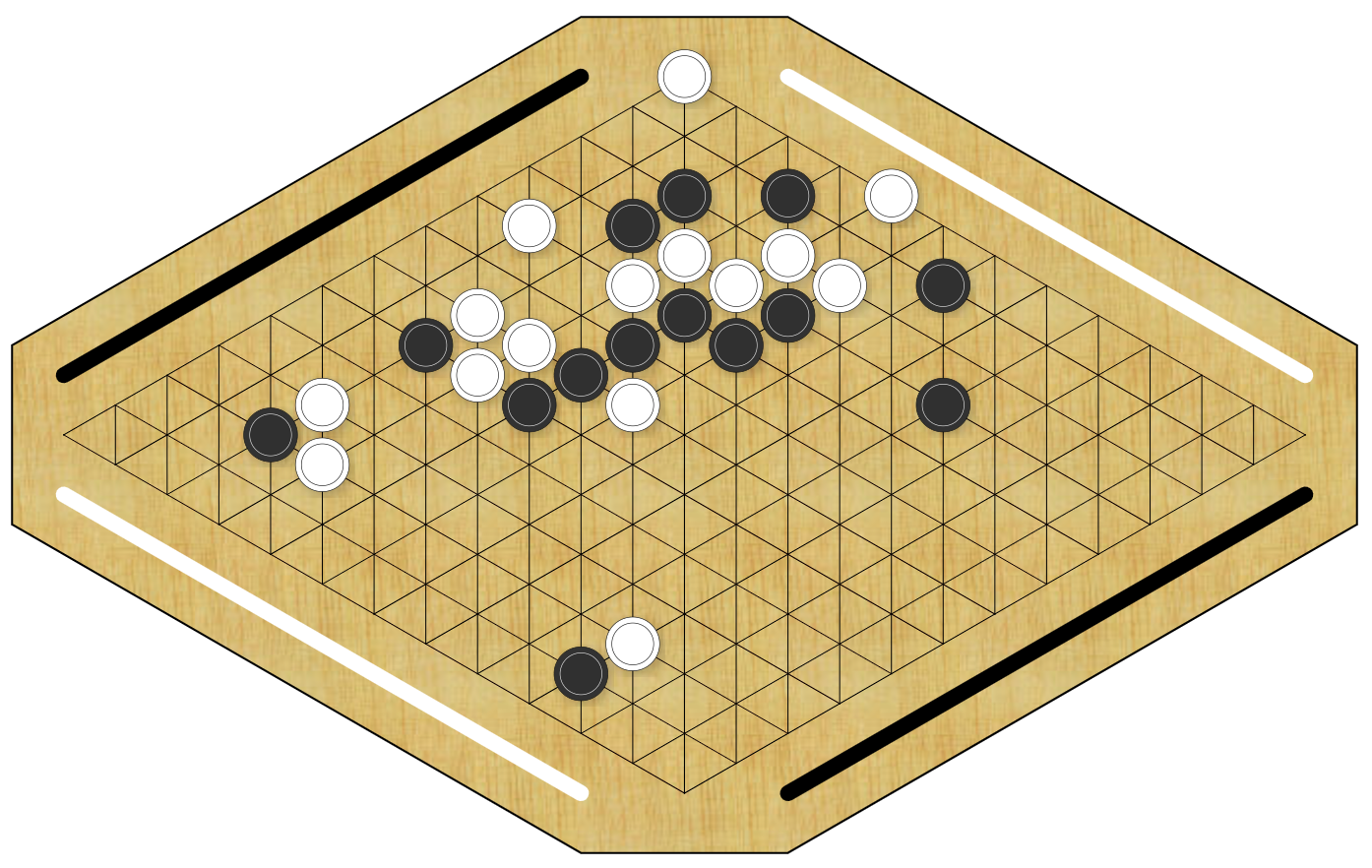
Rules
Each player is assigned a pair of opposite sides of the board which they must try to connect by taking turns placing a stone of their color on any empty space. Once placed, the stones cannot be moved or removed. A player wins when he successfully connects his sides by a chain of adjacent stones. Due to the topology of the game board, draws in Hex are impossible.
In the picture, black has connected his two sides and is the winner of the game.

Swap move
After the first move, the second player can play a swap move and switch sides.
Variants
On Little Golem is Hex played on four board sizes: 11, 13, 15 and 19.
Links
- Online Puzzles - great site with interactive puzzles by Matthew Seymour and with A Strategy Guide
- Hex Strategy: Making the Right Connections - book written by Cameron Browne
- Wikipedia - history of the game, rules, variants.
- Hex on BGG
- Hex - hex game directly from Piet Hein’s site.
19 - Line of Action
Rules
Lines of Action (or LOA) is an abstract strategy board game for two players invented by Claude Soucie. The objective is to connect all of one’s pieces into a single group. The game was recommended by the Spiel des Jahres in 1988.
The object of the game is to bring all of one’s pieces together into a contiguous body so that they are connected vertically, horizontally or diagonally.
Movement
- Players alternate moves, with Black having the first move.
- Pieces move horizontally, vertically, or diagonally.
- A piece moves exactly as many spaces as there are pieces (both friendly and enemy) on the line in which it is moving.
- A piece may not jump over an enemy piece.
- A piece may jump over friendly pieces.
- A piece may land on a square occupied by an enemy piece, resulting in the latter’s capture and removal from the game.
- A player who is reduced to a single piece wins the game, because his pieces are by definition united. If a move results, due to a capture, in each player having all his pieces in a contiguous body, then either the player moving wins, or the game is a draw.
Initial position

Final position
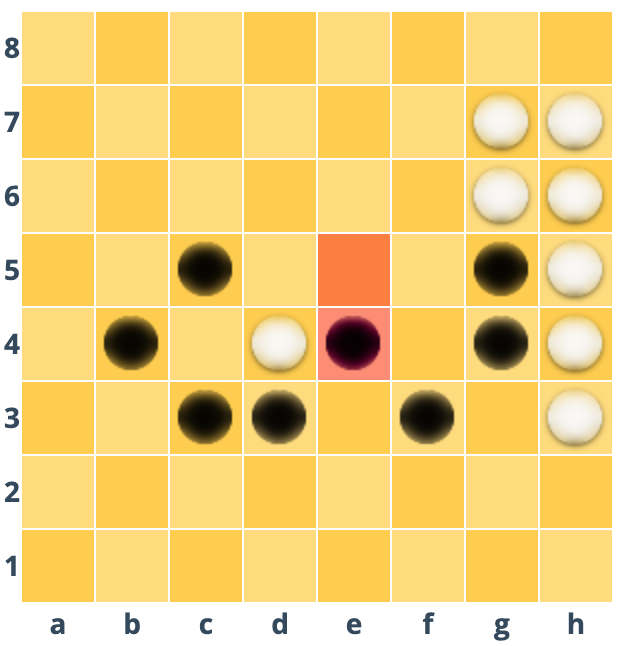
Variants
On Little Golem are implemented these versions of Line of Action.
Main variant
Standard variant played on 8x8.

Scramble
The variant has a different starting position.
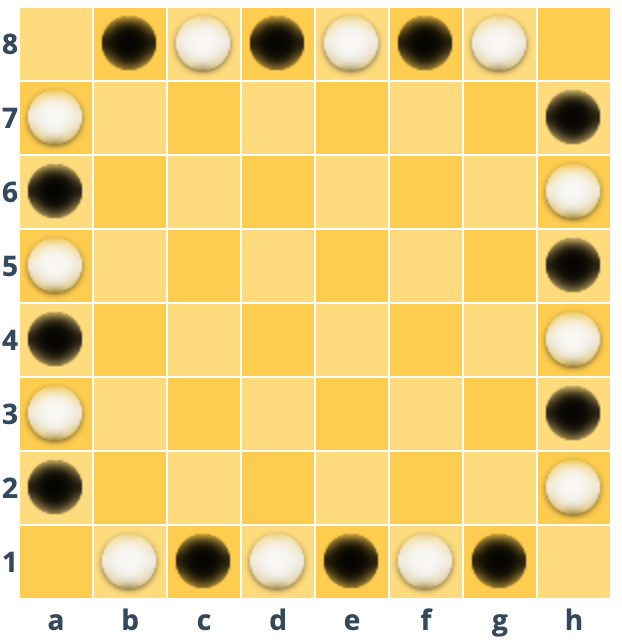
Quick
The variant has a different starting position.
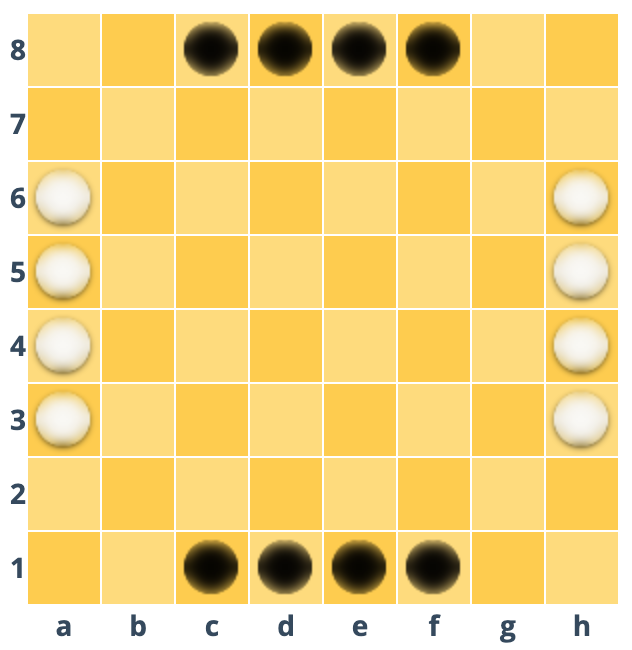
Blackhole
The variant is played on a 9x9 board. There is a black hole in the middle of the board where every stone disappears.
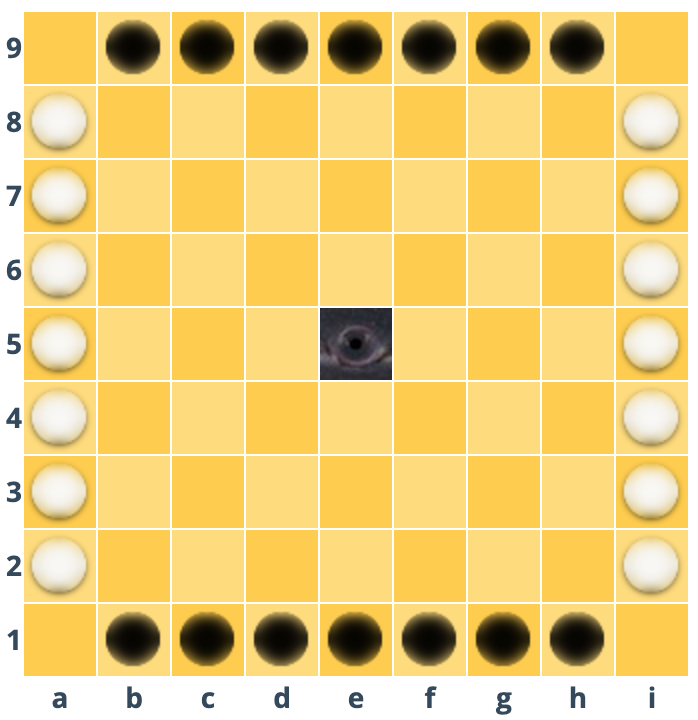
Links
22 - Oski
Rules
The game is very simple and can also be played as a paper and pencil game.
Board
Hexagonal board with 37 squares. The middle three squares can be of a different color.
Initial move
The player plays a three letter word into the marked square. Or the game is started with a random three letter word. This initial move is without points.
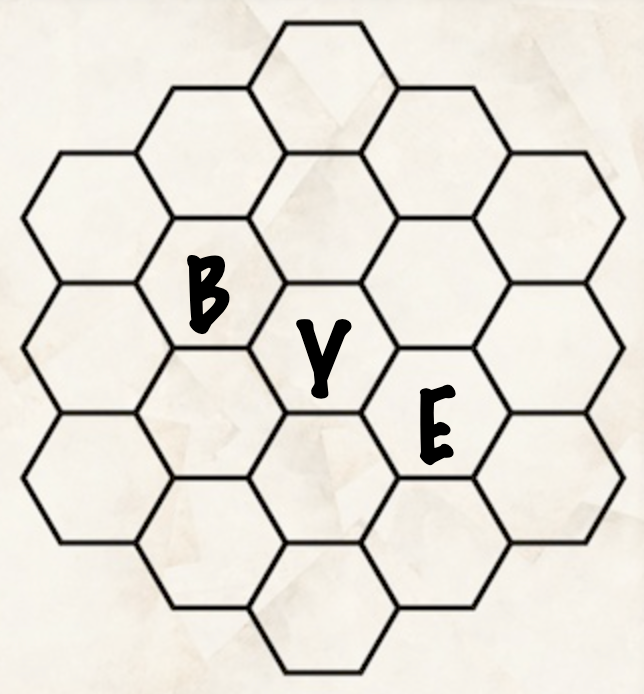
Next moves
The next player is in the game. For each move, the player puts a letter on the board and finds a word with that new letter. The length of the word is the score for that move. Example: move BYRE. The player scores four points. He now has 6.5 points. 4 points for words and 2.5 Komi.
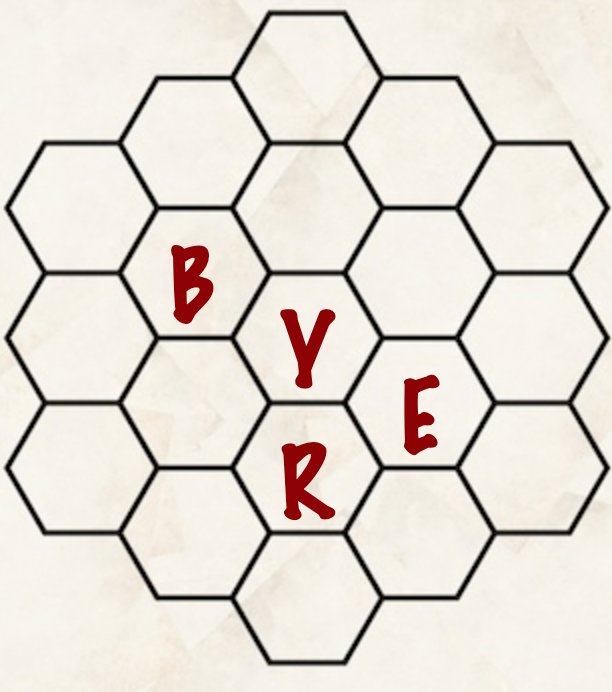
Next rules
- It is not possible to use already used words or words whose parts are already used. For example, if in the game the words BYE and BYRE were used, it is not possible to use the words ABYE, BYRES, FORBYE, GOODBYE, UPBYE, …
- The initial move does not count for points.
- The game ends when the board is full.
- The first player has 2.5 points komi.
Whole game example

Initial move: NEB
| First player | Score | Second player | Score |
|---|---|---|---|
| BEEN | 6.5 | BEER | 4.0 |
| GREEN | 11.5 | AGREE | 9.0 |
| ANGRY | 16.5 | BEANERY | 16.0 |
| DEANERY | 23.5 | GREEDY | 22.0 |
| RENEW | 28.5 | TWEEDY | 28.0 |
| BETWEEN | 35.5 | TWEEDS | 34.0 |
| SWANG | 40.5 | NEWEST | 40.0 |
| GAMEST | 46.5 | WESTERS | 47.0 |
Variants
Game is played in 7 languages
23 - Polyomino
Polyomino is a simple board game with polyominoes. The game can be played as a paper-and-pencil game.
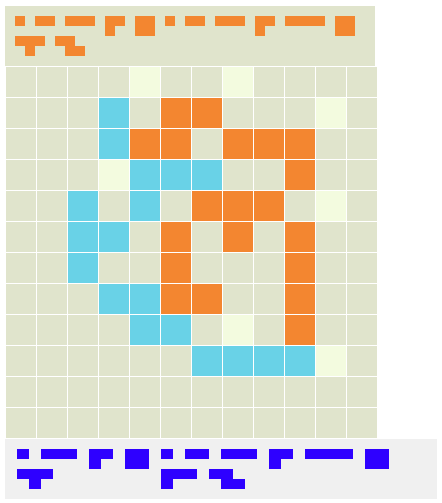
Rules
- Each player has a set of polyomino tiles, except in the hexa variant.
- The first player places a blue polyomino tile and an orange polyomino tile.
- The second player continues as the blue player or switches sides and the first player continue as the blue player.
- The next tile must be placed so that it touches at least one tile of the same color with its corners. The edges of tiles of the same color must not touch.
- If a player cannot place a tile, he passes.
- When there is no move, game is finished. Player with the most tiles wins the game.
Variants
Mini. Game on the board 8x8. Each player has 1 monomino, 1 domino, 2 trominos and 5 tetrominos.
Small. Game on the board 12x12. Each player has two sets from mini variant.
Penta. Game on the board 14x14. Each player has 1 monomino, 1 domino, 2 trominos, 5 tetrominos and 12 pentominoes.
Hexa. Game on the board 20x20. The game is played only with one common set of pieces: 1 monomino, 1 domino, 2 trominos, 5 tetrominos, 12 pentominos and 35 hexominos.
24 - QYPS
Rules
The game is played on a triangular board. The game is played with special stones. The stones have two sides (white and black). Each stone has two different colors. The game can be played on any board size:
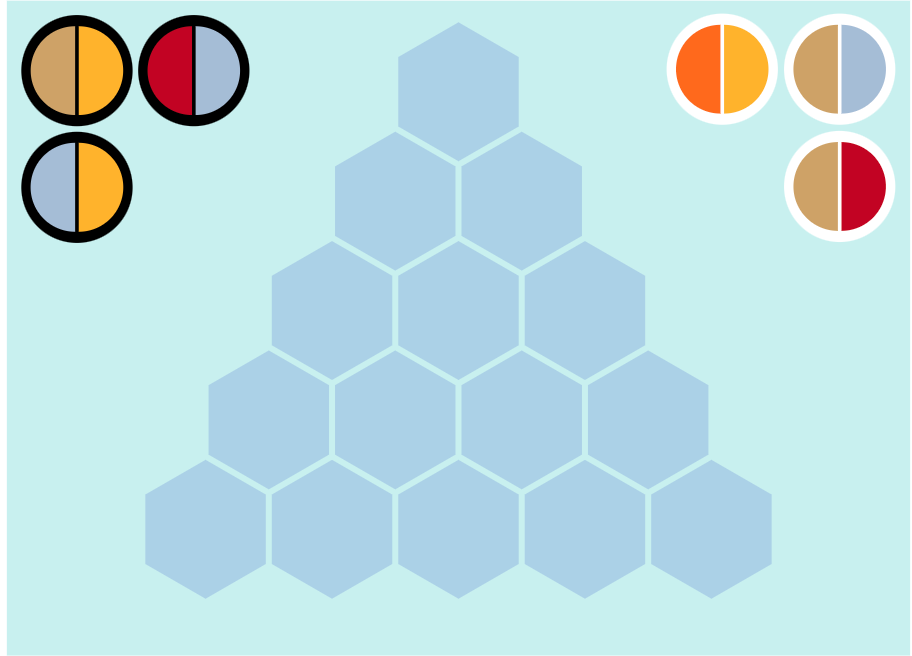
- Number of colors is size+1
- All color combinations are in game
- The number of stones is equal to the number of fields on the board
- The size of rack for player’s stones depends on size of board (3 for size 5, 5 for size 8)
- Each player has his own stones on rack. When it is a player’s turn, he can put several stones on the board. All stones must be connected to each other and have the same color. After the turn, the player chooses stones from a bag.
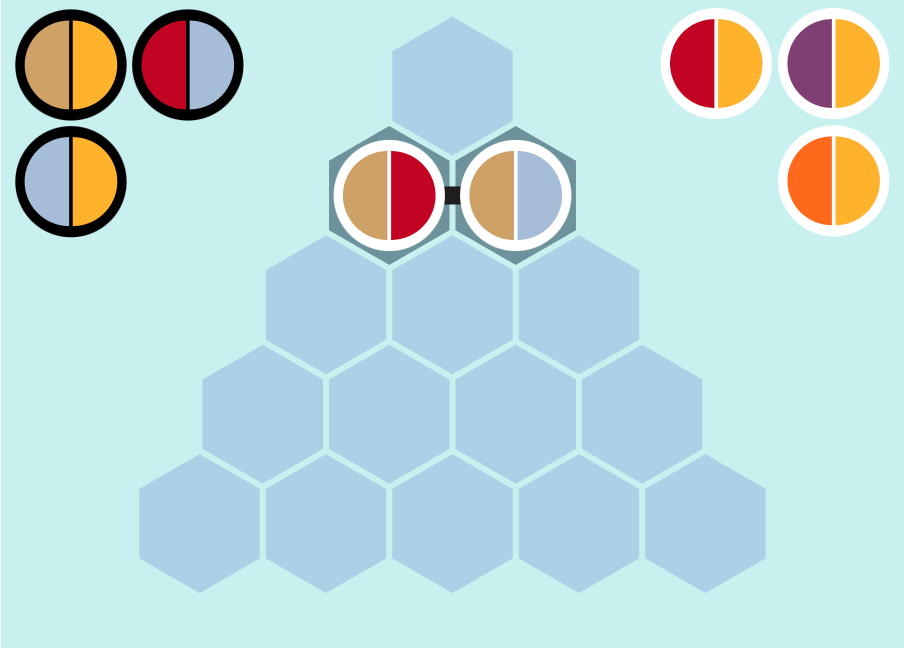
It is also possible to use stones on the board. I can flip one of the opponent’s stones to my color (if all connected stones are in a row, all opponent’s stones are flipped).
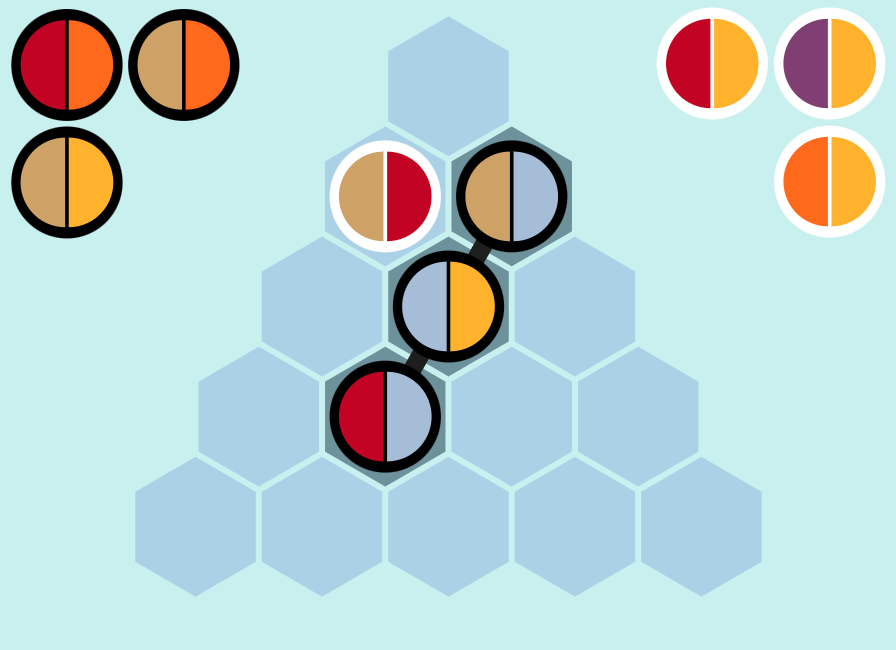
The player who has connected all sides of the board at the end of the game is the winner.
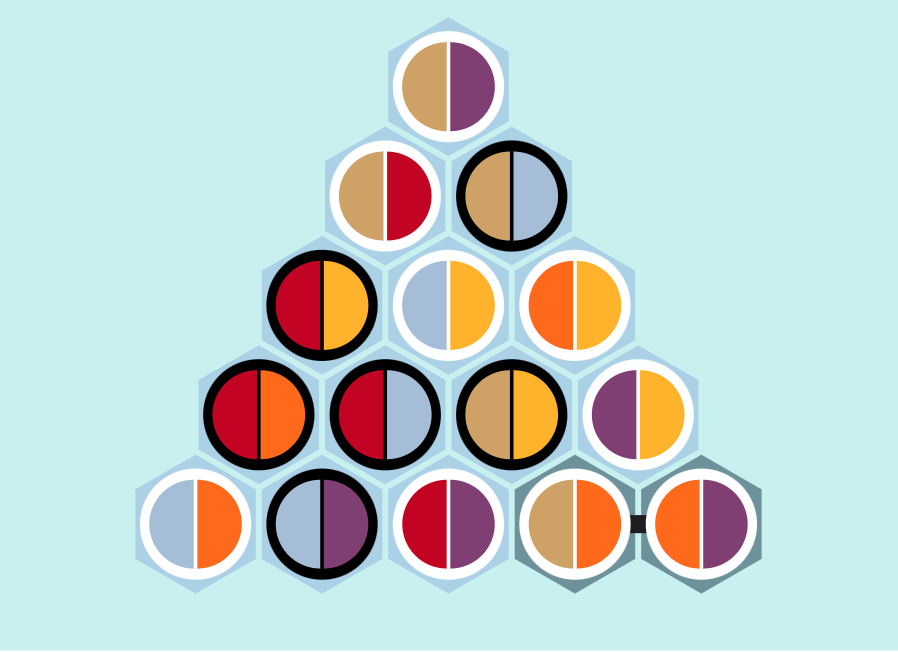
26 - Tumbleweed
Tumbleweed is a two-player game. It is played on a hexhex board and a sufficient supply of stacked checkers.
A stack can “see” a hex, when they are connected by a straight line, with no stacks in between. The players take turns placing stacks of their tokens on hexes that are seen by at least one friendly stack. The height of every newly-placed stack equals the number of your stacks that see the new stack. Replacing an existing stack with a new stack is possible, as long as the new stack is taller than the previous one. This works with opponent stacks (to capture), or your own stacks (to reinforce).
Before the game, the host sets up the board and the guest decides which side he wants to play. Setup consists of one stack of two neutral tokens in the central hex, and a single starting token for each player in hexes of the host’s choosing.
The game ends when no more moves can be made by either player, or after two successive passes. The player who occupies over half the board wins.
Links
The best article about Tumbleweed is on Abstract Games
Variants
On Little Golem are supported four sizes of board: 4,6,8 and 11.
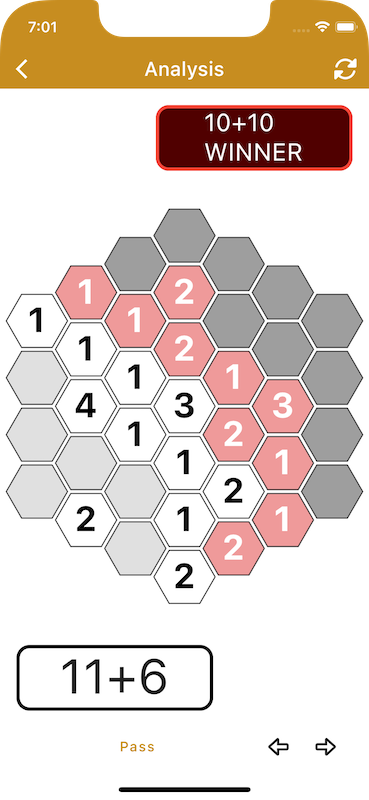
27 - Shogi
28 - Slither
29 - Street soccer
30 - Twixt
31 - Tzaar
32 - WYPS
Short story
The first version of the game was invented in 2002. The game was played with different rules on the Little Golem server. More than 20 variants and more than 800 players were played until the final rules were released.
Rules
WYPS is an abstract word game for two players.
Components
The game is played on triangular board with hexagonal squares. The rules are the same for all sizes of the board.
White’s first move is HIP
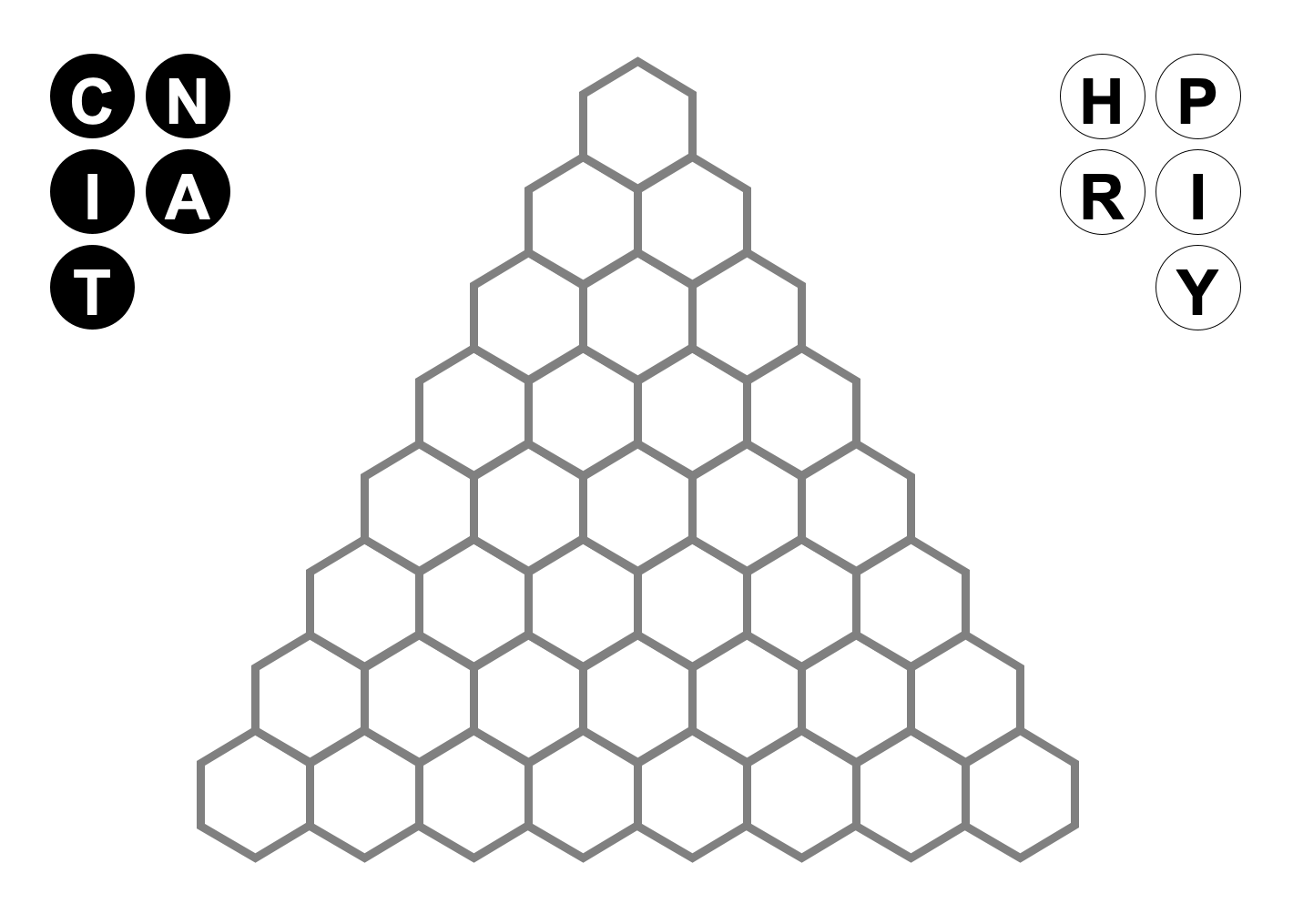
There are stones with letters. The stones have two different sides, each side representing one player. On each stone there is exactly one letter. The number of stones corresponds to the number of squares on the board (36 for size 8). At the beginning of the game, all the stones are in a bag.
Swap move
Each player draws five stones (five for size 8) from the bag. The black player can swap the stones between the players. All letters must always be swapped.
Gameplay
The players form words from their letters and from the letters on the board. If a player uses the opponent’s letters on the board, he turns one letter from these tiles to his own side. Instead of forming a word, it is possible to place only one letter from the rack on the board. At least one letter from the tray must be used in the turn. After the turn, up to seven letters are drawn from the tray (depending on the size of the board) if the bag is not empty. The first move is made by the white player. If the player forms the word in a straight line, she turns all used opponent’s letters to her own side.
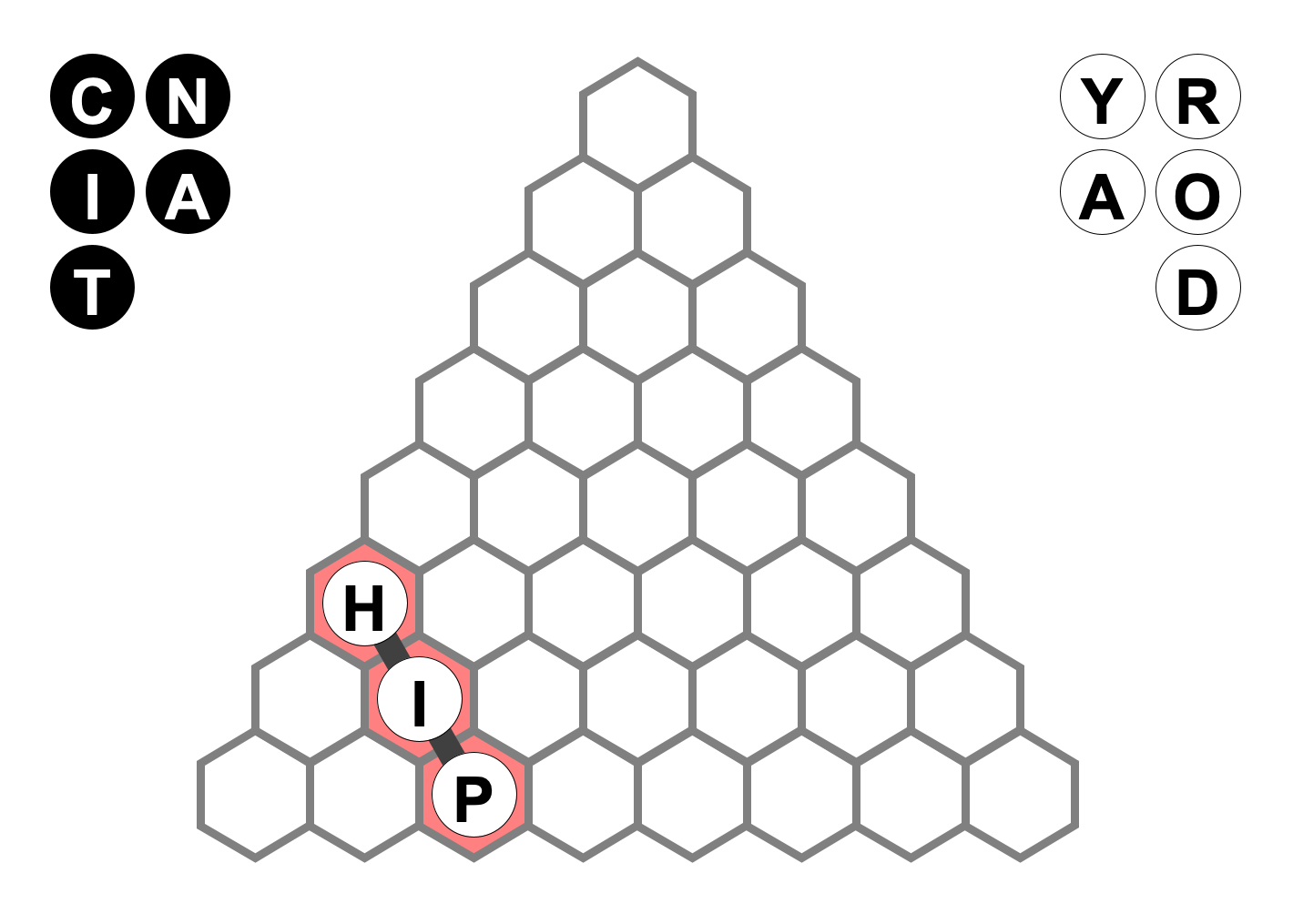
Play continues with the next player.
Black player play move CHINA and turns over a stone.
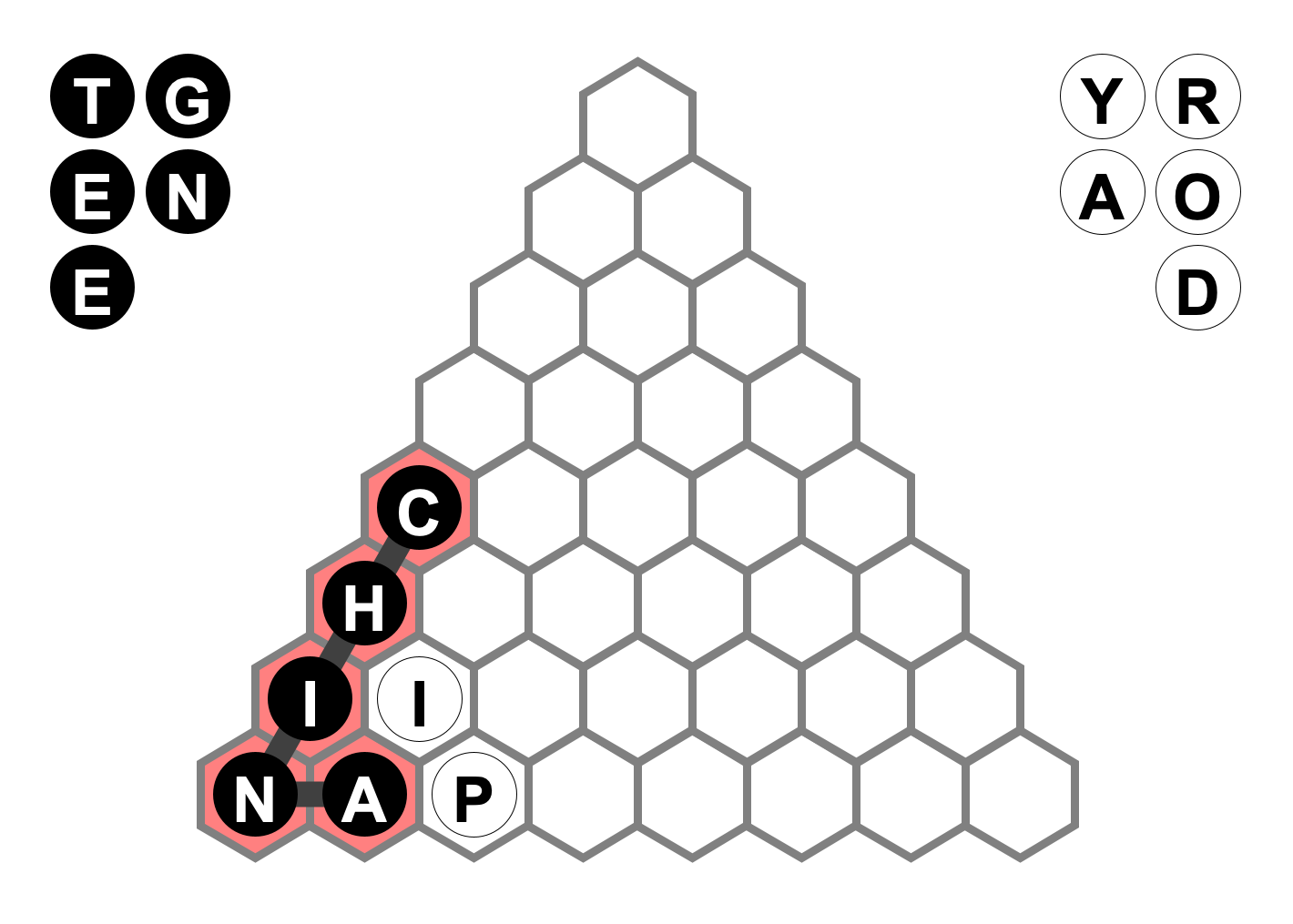
White play move ARCH in a straight line and turns over all used oponent’s stones.
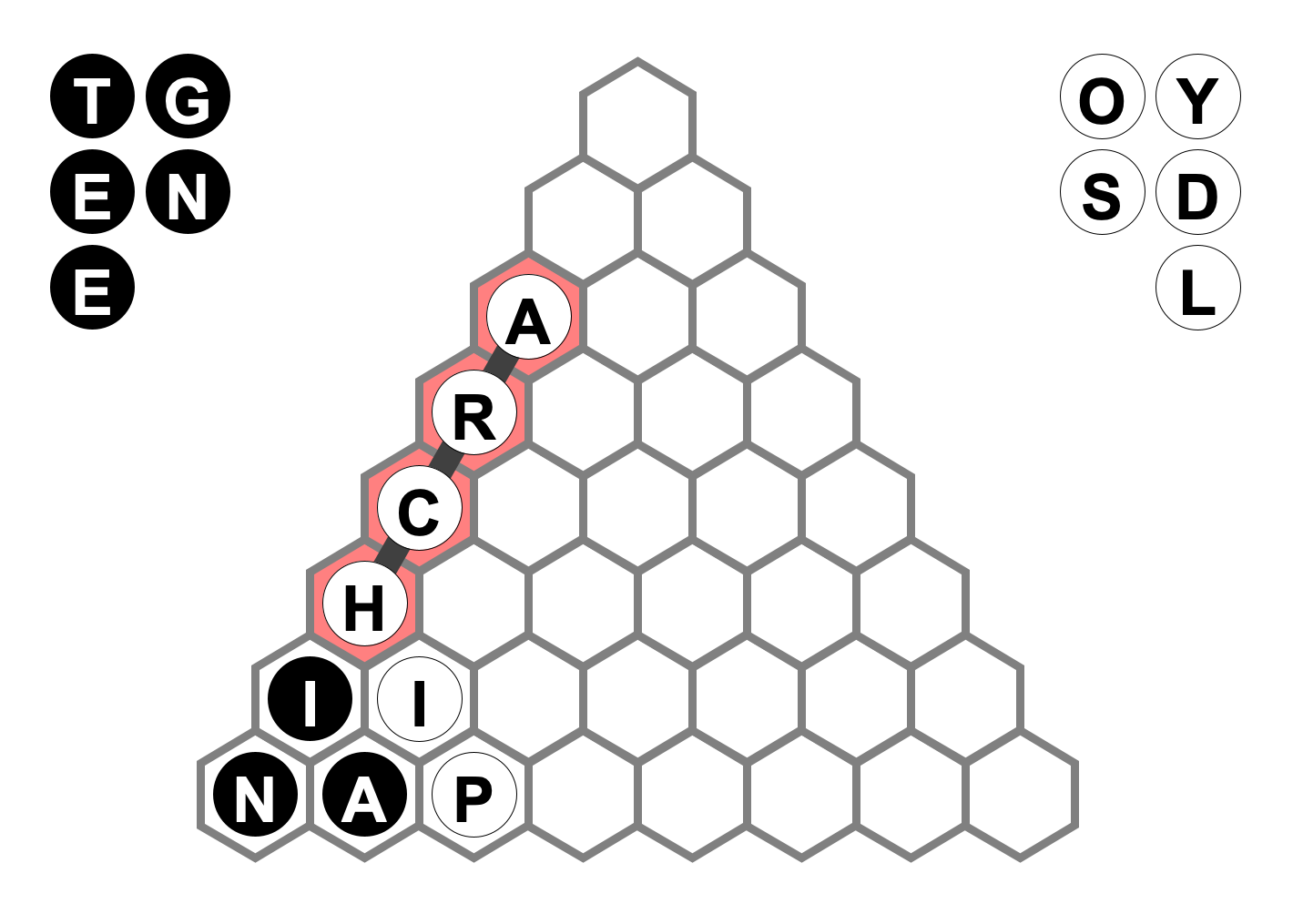
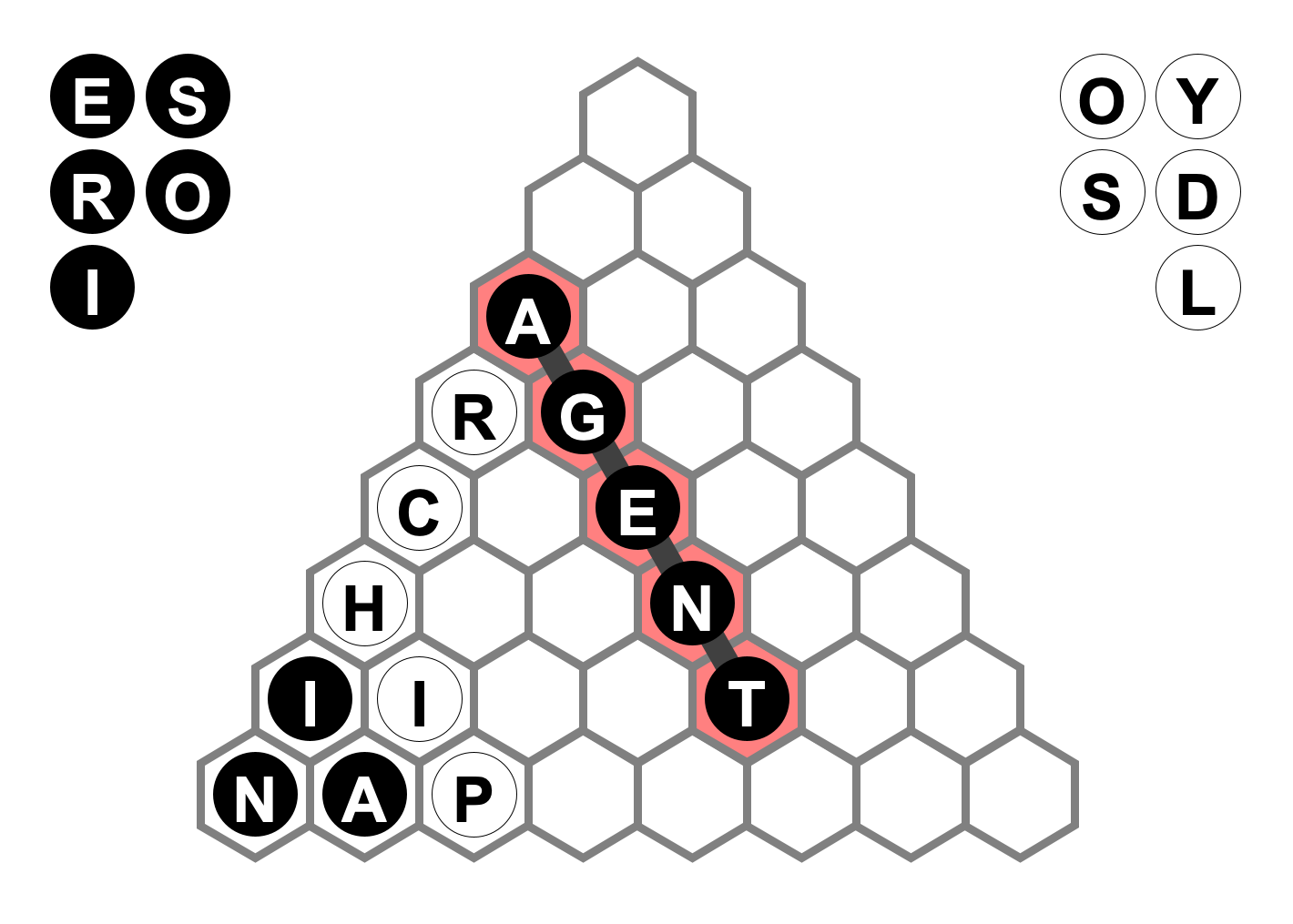
Goal of a game
The object of the game is to form a group of stones connected to all three sides of the board.
White plays DOES and connects all three sides of the board. This move is called atari (attack). Black’s move must break this connection.
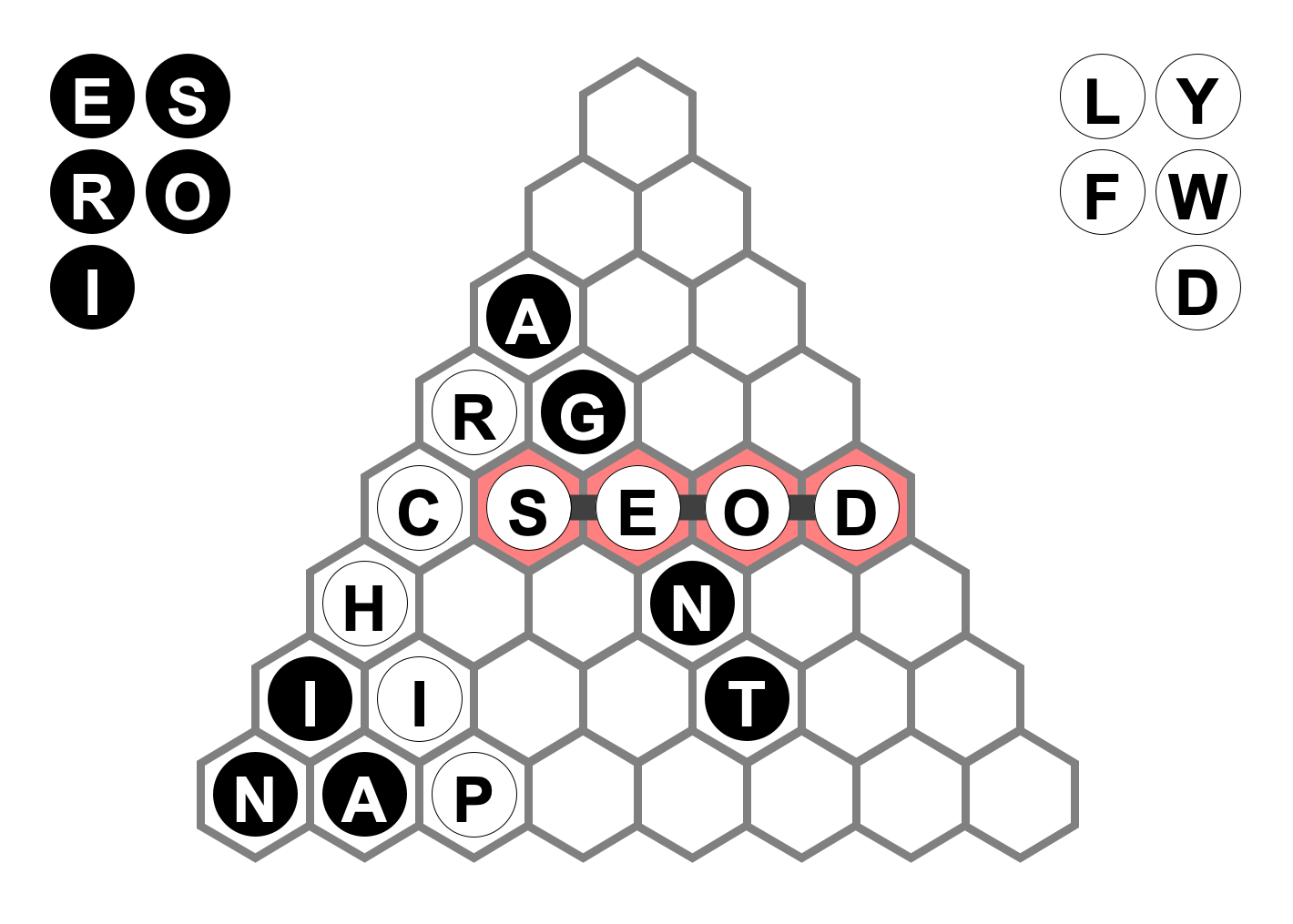
Black’s move SEARCH interrupts White’s atari. And this black move is also an atari.
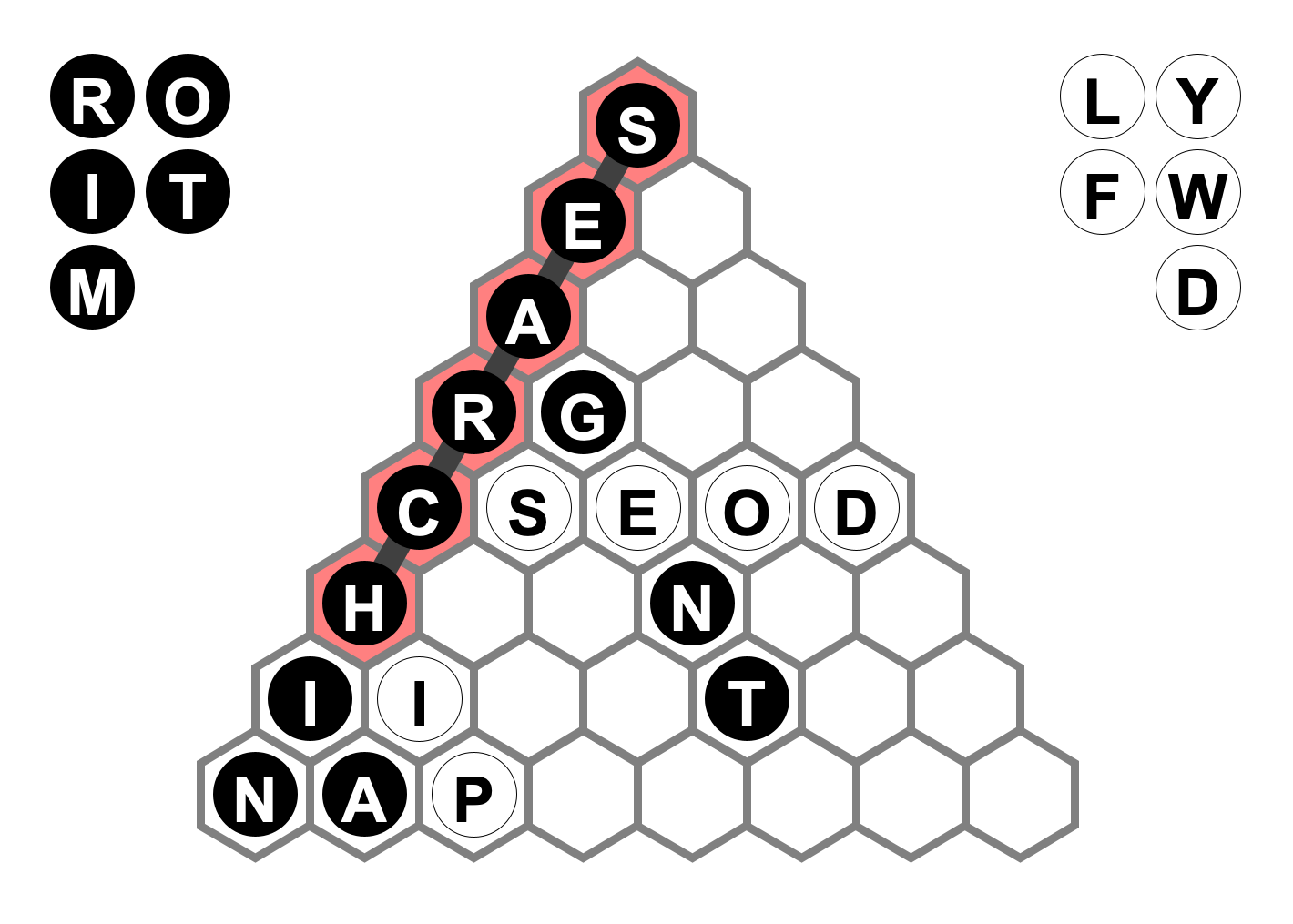
White plays the move CHILD. White used two letters from rack and two opponent’s stones. She can flip C or H to the white side. She decides to flip the letter H.
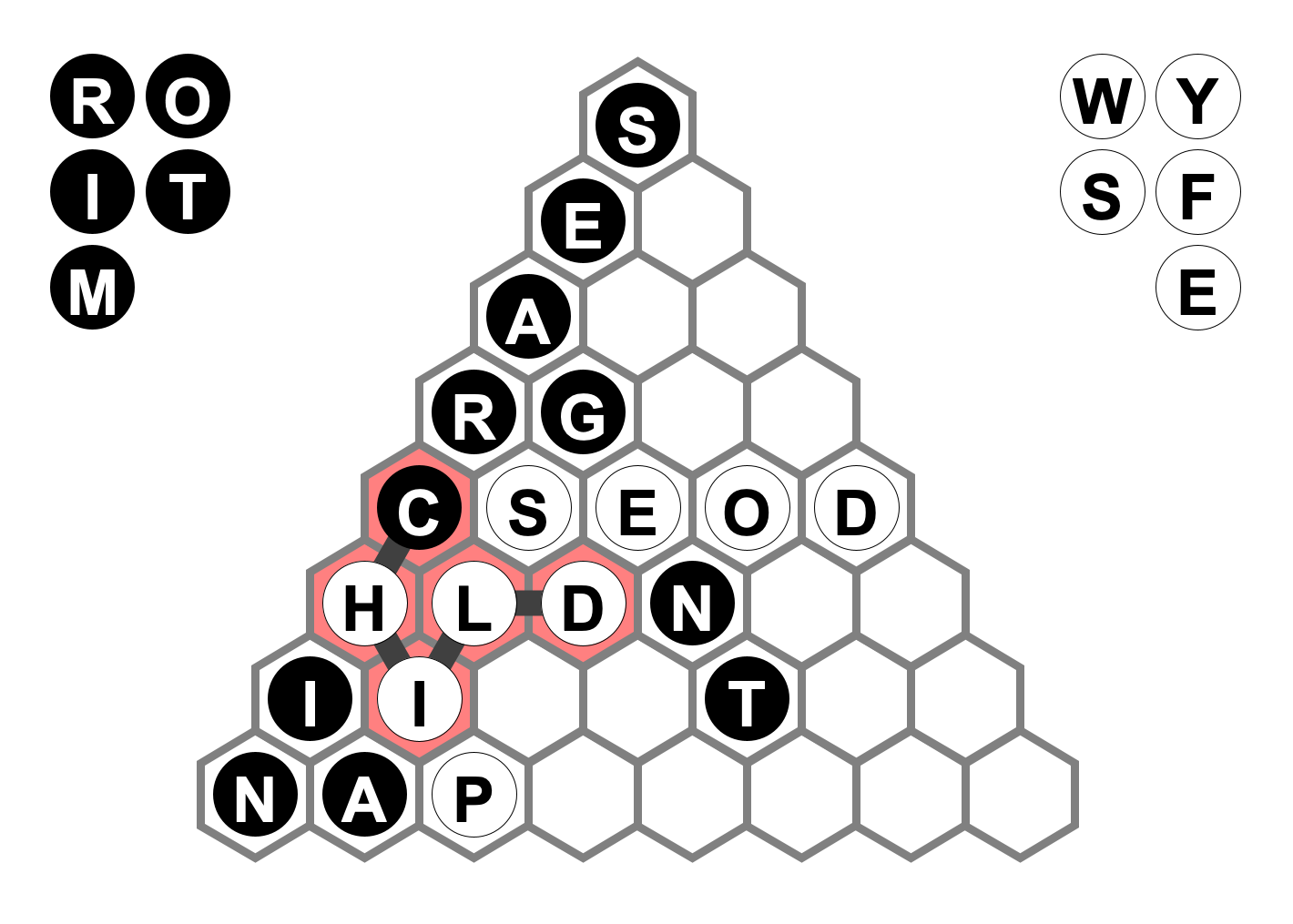
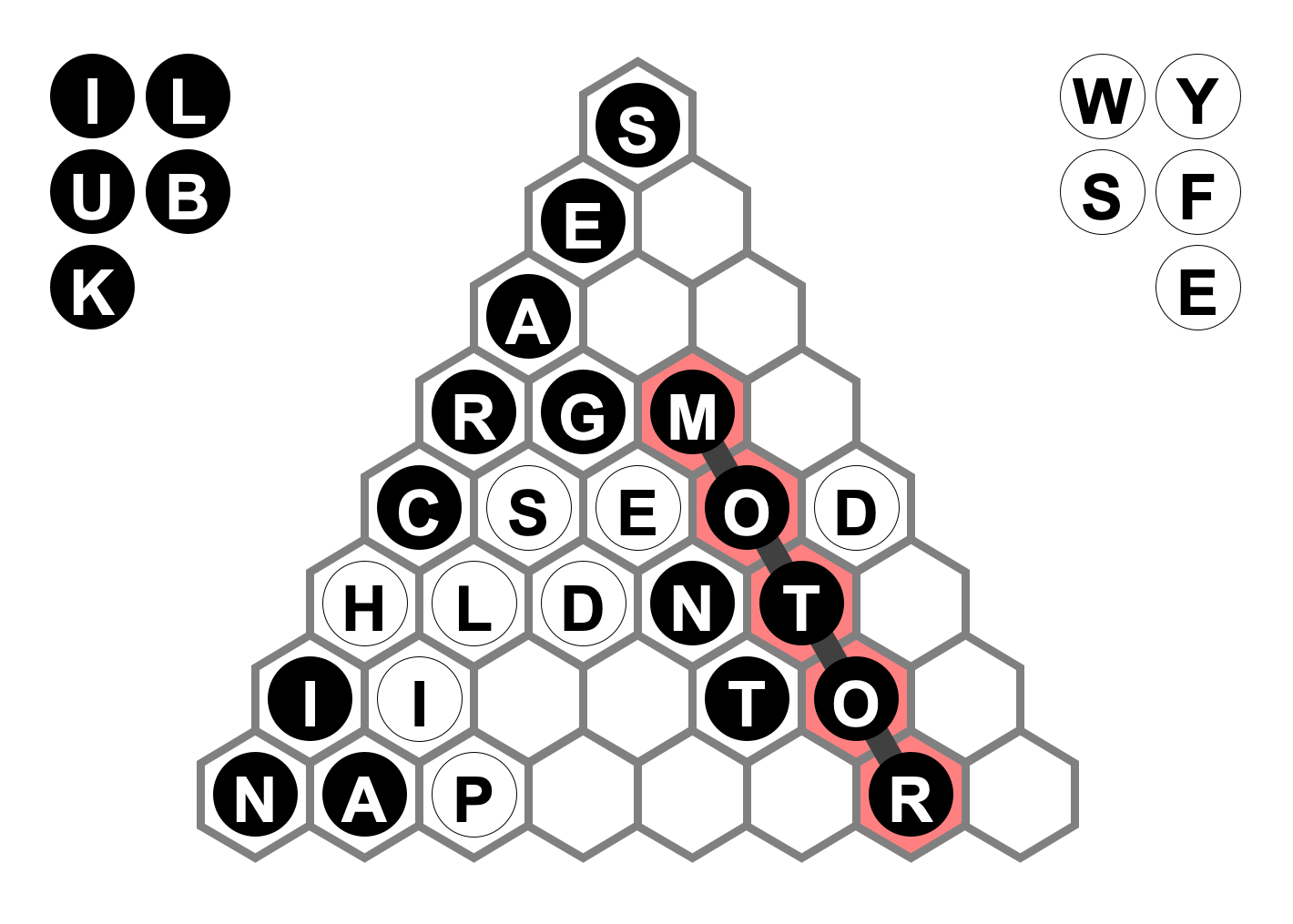
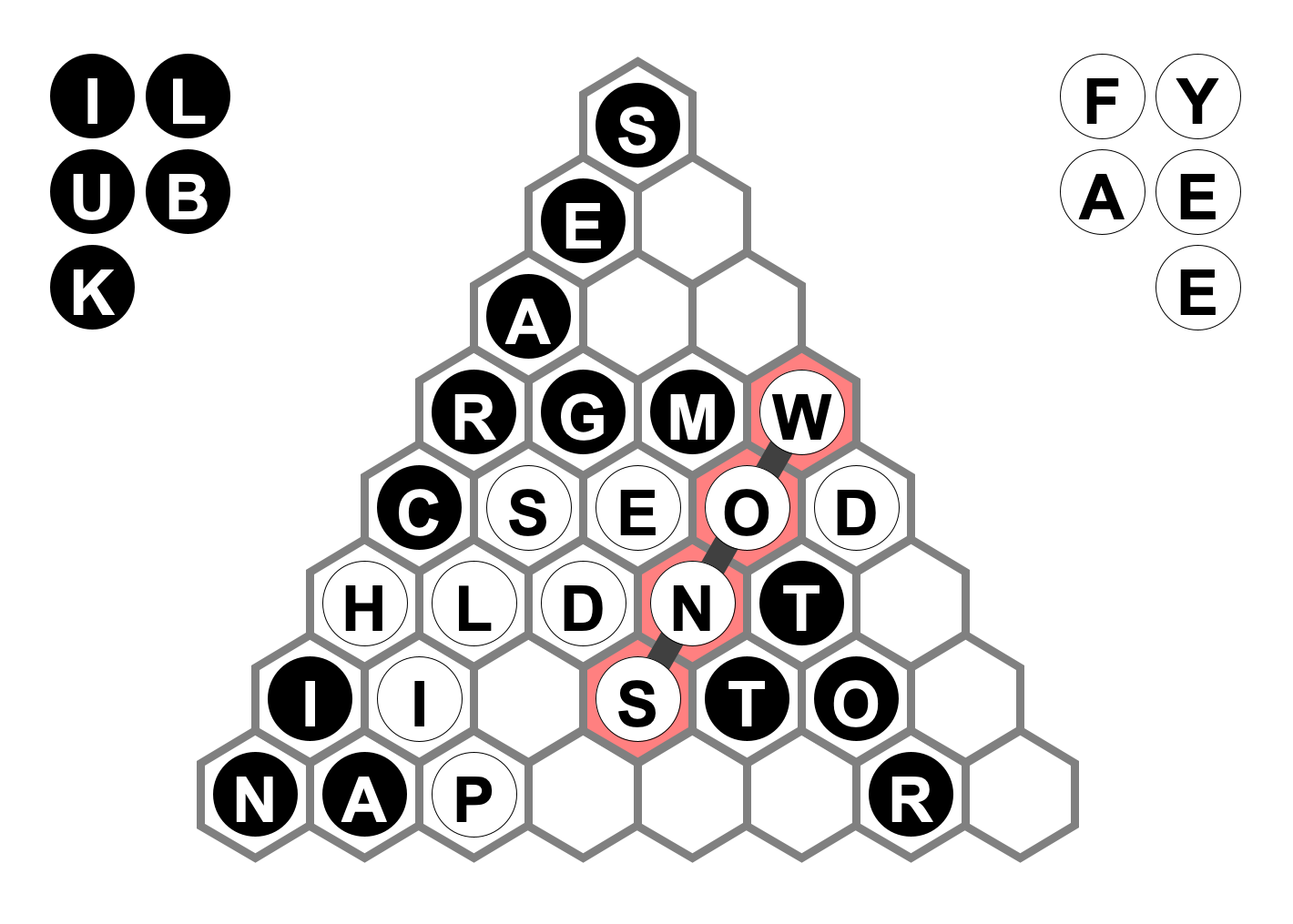
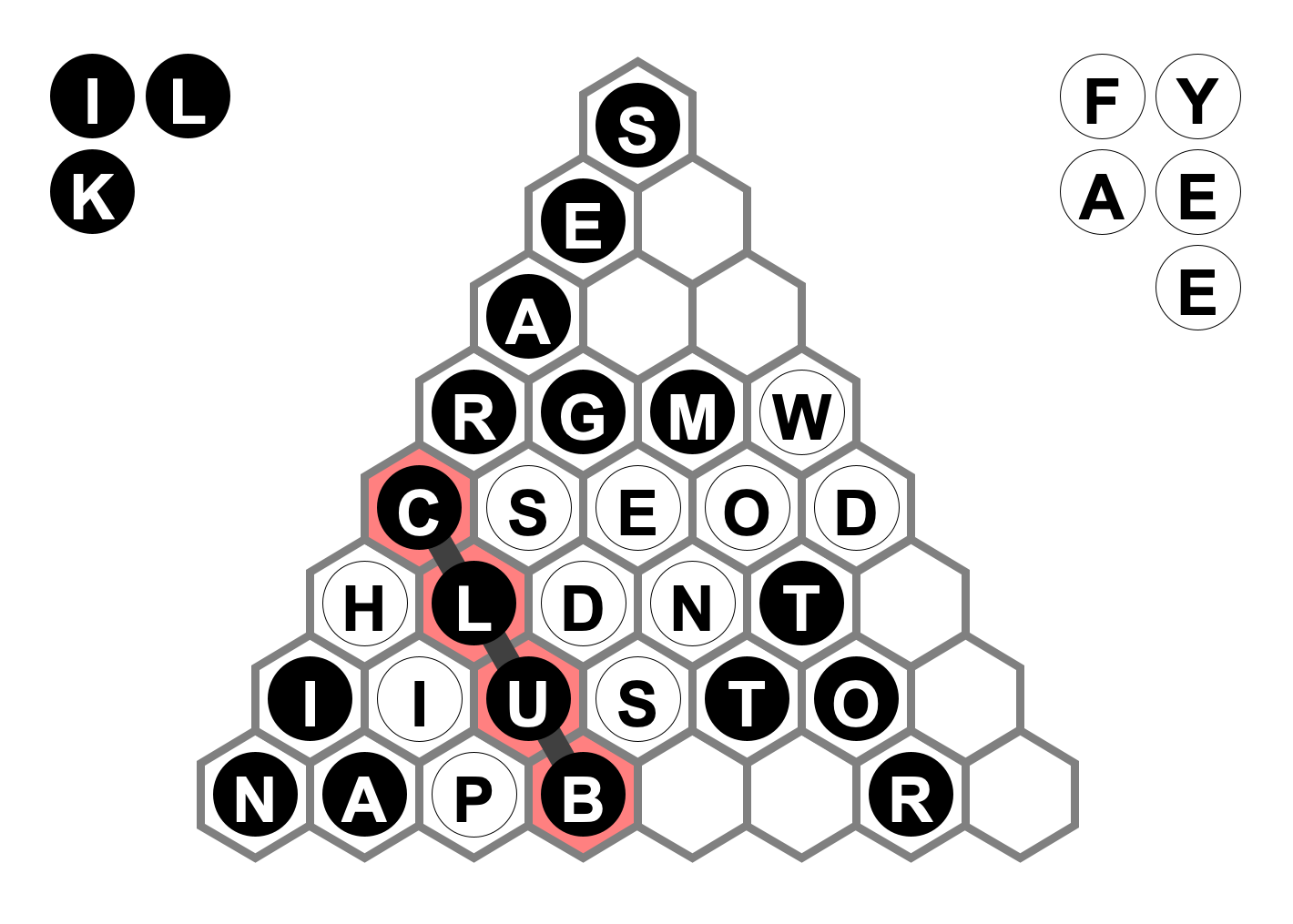

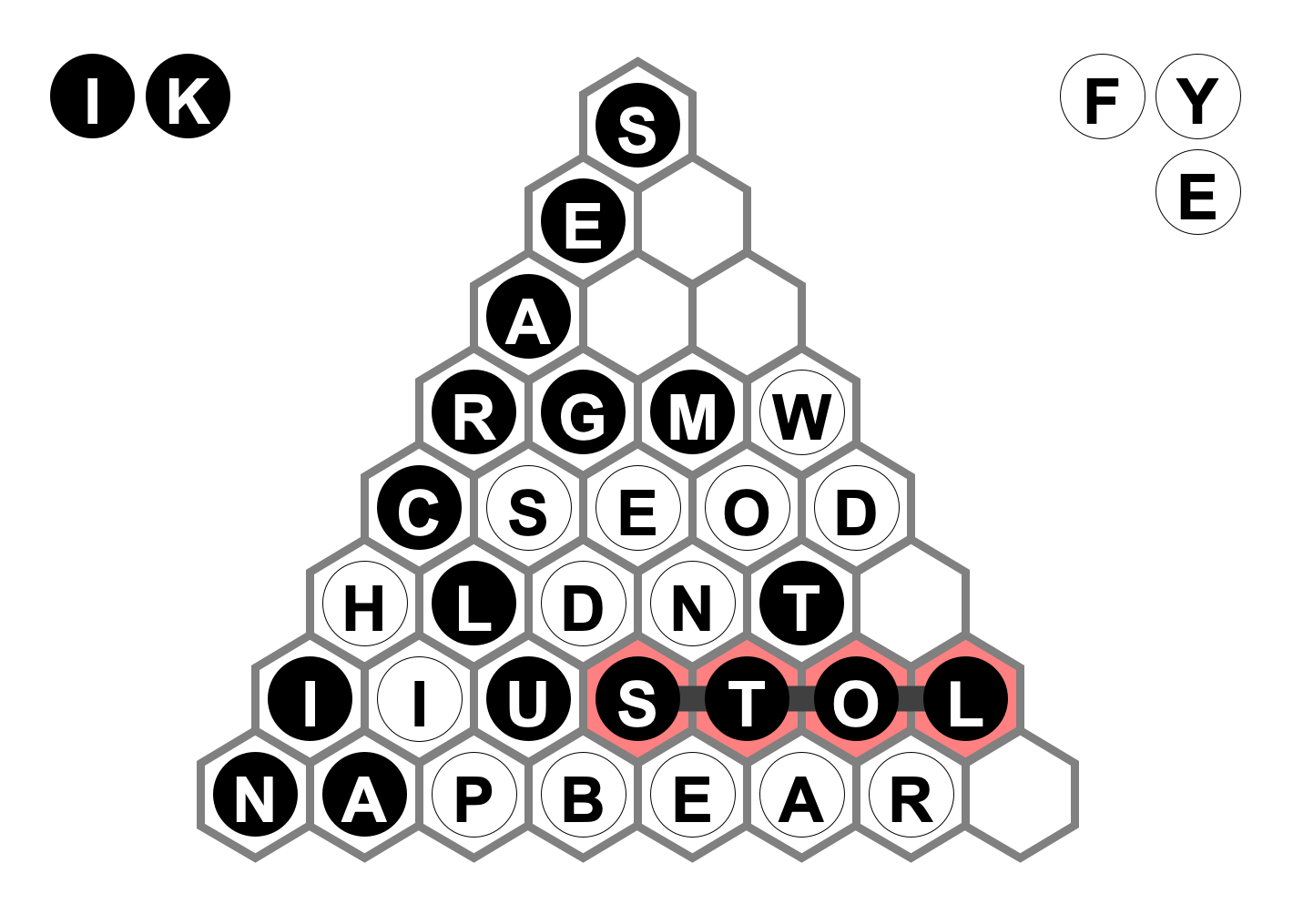
End of game
Play continues as long as a player’s group is not connected to all three sides of the board, and the opponent on his turn is unable to break it off. Note that the corners are considered to belong to the two adjacent sides.
White’s move FLED. After this move, black is not able to find the next move. Black gives up the game and White is the winner.
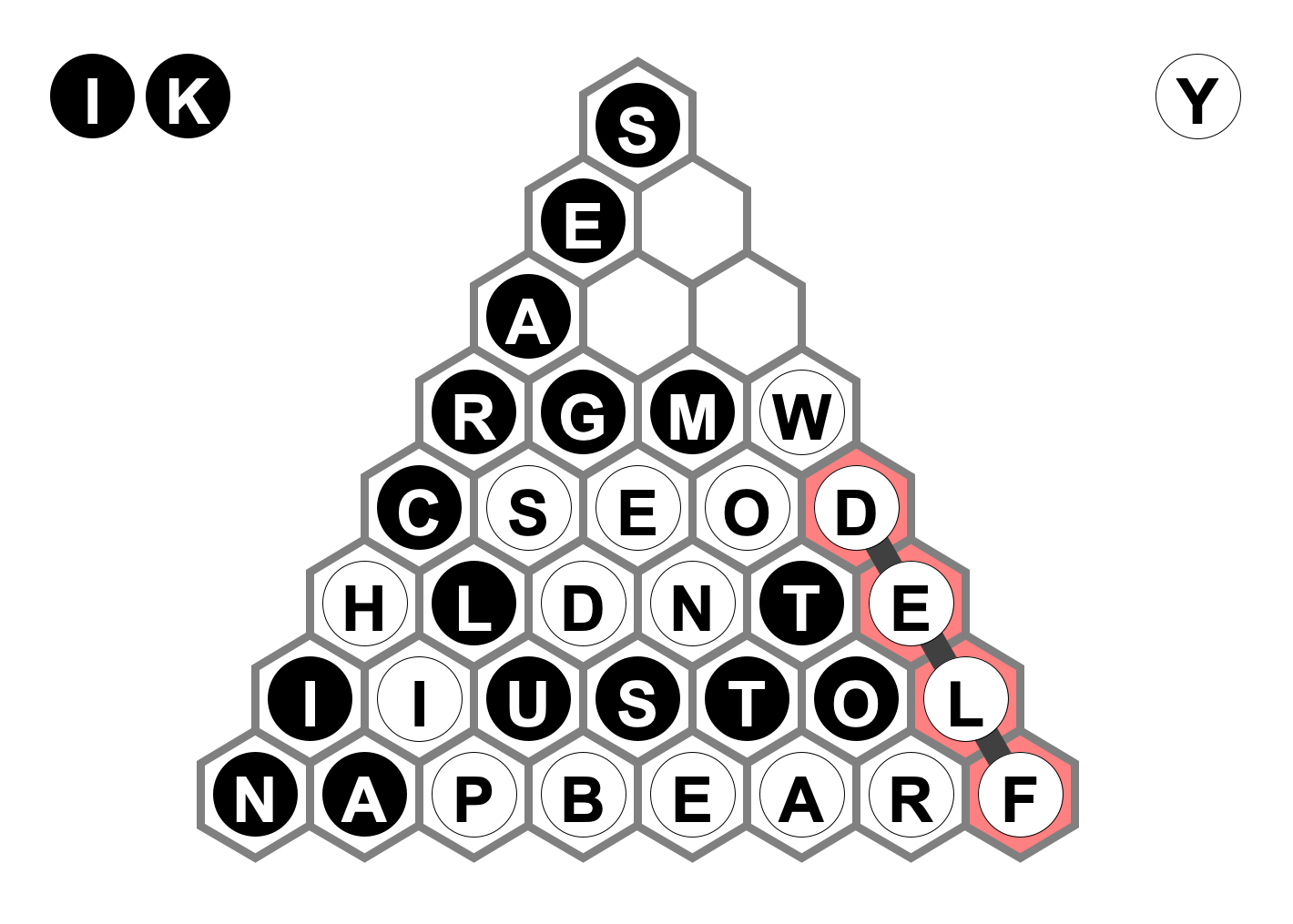
Variants on Little Golem
WYPS is played on Little Golem in multiple languages on sizes: 5,8,11 and 14.
There is also a numeric version where the letters are replaced by numbers. You must play even numbers or sequences of numbers.
Board sizes and letter distribution
WYPS can be played on any board sizes and in any language.
English
| Size | Rack size | Board size | Letters |
|---|---|---|---|
| 5 | 3 | 15 | ACDEEILMNO PRSTU |
| 6 | 4 | 21 | AABCDEEGHI LMNOPRSSTU Y |
| 7 | 4 | 28 | AABCDEEEFG HIIKLMNOOP RRSSTUWY |
| 8 | 5 | 36 | AAABCDDEEE EFGHIIIKLL MNNOOPRRSS STTUWY |
| 9 | 6 | 45 | AAAABCCDDE EEEEFGHIII KLLMNNNOOO PRRRSSSSTT UUVWY |
| 10 | 6 | 55 | AAAAABCCDD EEEEEEFGGH IIIIKLLLMM NNNOOOPPRR RRSSSSSTTT UUVWY |
| 11 | 7 | 66 | AAAAABBCCD DDEEEEEEEF GGHHIIIIIK LLLMMNNNNO OOOPPRRRRS SSSSSTTTTU UUVWYZ |
| 12 | 8 | 78 | AAAAAAABBC CCDDDEEEEE EEEEFGGHHI IIIIIKKLLL LMMNNNNOOO OOPPRRRRRS SSSSSSTTTT UUUVWYYZ |
| 13 | 9 | 91 | AAAAAAABBC CCDDDDEEEE EEEEEEFFGG GHHIIIIIIK KLLLLLMMMN NNNNOOOOOO PPPRRRRRRS SSSSSSSTTT TTUUUUVWYY Z |
| 14 | 9 | 105 | AAAAAAAABB BCCCCDDDDE EEEEEEEEEE EFFGGGHHHI IIIIIIIKKL LLLLLMMMNN NNNNOOOOOO PPPRRRRRRR SSSSSSSSSS TTTTTTUUUU VWYYZ |
German
| Size | Rack size | Board size | Letters |
|---|---|---|---|
| 5 | 3 | 15 | AEEGHIKLMN ORSTU |
| 6 | 4 | 21 | ABDEEEFGHI KLMNOPRSTT U |
| 7 | 4 | 28 | AABCDEEEEF GHIKLMNNOP RRSSTTUZ |
| 8 | 5 | 36 | AABCDEEEEE FGHIIKLLMN NNOPRRRSSS TTTUZÄ |
| 9 | 6 | 45 | AAABCDEEEE EEEFGGHHII KLLMNNNOOP RRRSSSTTTT UUWZÄ |
| 10 | 6 | 55 | AAABBCDEEE EEEEFGGHHI IIKKLLLMMN NNNOOPRRRR SSSSTTTTUU WZÄÖÜ |
| 11 | 7 | 66 | AAAABBCDDE EEEEEEEEFF GGHHIIIKKL LLMMNNNNNO OPPRRRRRSS SSSTTTTTUU VWZÄÖÜ |
| 12 | 8 | 78 | AAAAABBCCD DEEEEEEEEE EEFFGGGHHH IIIIKKLLLL MMNNNNNOOO PPRRRRRSSS SSSTTTTTTU UUVWZÄÖÜ |
| 13 | 9 | 91 | AAAAAABBBC CDDEEEEEEE EEEEEEEFFG GGHHHIIIIK KKLLLLLMMM NNNNNNOOOP PRRRRRRSSS SSSSTTTTTT TUUUUVWZÄÖ Ü |
| 14 | 9 | 105 | AAAAAAABBB CCDDDEEEEE EEEEEEEEEE EFFGGGGHHH HIIIIIKKKL LLLLMMMNNN NNNNNOOOPP RRRRRRRSSS SSSSSTTTTT TTTTUUUUVW ZZÄÖÜ |
Spain
| Size | Rack size | Board size | Letters |
|---|---|---|---|
| 5 | 3 | 15 | AACDEEILMN ORSTU |
| 6 | 4 | 21 | AAABCDEEGI LMNOOPRRST U |
| 7 | 4 | 28 | AAAAABCDEE EGIILMNOOO PRRSSTUV |
| 8 | 5 | 36 | AAAAAABCCD EEEEGIILLM NNOOOPRRRS SSTTUV |
| 9 | 6 | 45 | AAAAAAABCC DDEEEEEFGH IIIJLLMNNO OOOPRRRSSS TTUUV |
| 10 | 6 | 55 | AAAAAAAAAB CCDDEEEEEE FGHIIIIJLL LMMNNNOOOO PRRRRSSSST TUUVZ |
| 11 | 7 | 66 | AAAAAAAAAA ABBCCCDDDE EEEEEEFGHI IIIJLLLMMN NNOOOOOPPR RRRRSSSSST TTUUVZ |
| 12 | 8 | 78 | AAAAAAAAAA AAABBCCCDD DEEEEEEEEE FGGHIIIIIJ LLLLMMNNNN OOOOOOPPRR RRRRSSSSSS TTTUUUVZ |
| 13 | 9 | 91 | AAAAAAAAAA AAAAABBCCC CDDDDEEEEE EEEEEFGGHI IIIIIJLLLL MMMNNNNNOO OOOOOPPRRR RRRRSSSSSS STTTTUUUVZ Ñ |
| 14 | 9 | 105 | AAAAAAAAAA AAAAAAAABB CCCCDDDDEE EEEEEEEEEE FGGHIIIIII IJLLLLLMMM NNNNNNOOOO OOOOPPPRRR RRRRRRSSSS SSSSSTTTTU UUVZÑ |
French
| Size | Rack size | Board size | Letters |
|---|---|---|---|
| 5 | 3 | 15 | AACEEILMNO PRSTU |
| 6 | 4 | 21 | AABCDEEEGI ILMNOPRSST U |
| 7 | 4 | 28 | AAABCDEEEF GHIILMNOOP RRSSTTUV |
| 8 | 5 | 36 | AAAABCDEEE EEFGHIIILM NNOOPRRSSS TTUUVZ |
| 9 | 6 | 45 | AAAAABCCDE EEEEEFGHII IILLMNNOOO PRRRSSSSTT TUUVZ |
| 10 | 6 | 55 | AAAAAABCCD EEEEEEEEFG HIIIILLLMM NNNOOOPPRR RRSSSSSTTT UUUVZ |
| 11 | 7 | 66 | AAAAAAABBC CDDEEEEEEE EEFGGHIIII ILLLMMNNNO OOOPPRRRRR SSSSSSTTTT UUUVYZ |
| 12 | 8 | 78 | AAAAAAAAAB BCCCDDEEEE EEEEEEEFGG HIIIIIILLL LMMNNNNOOO OPPRRRRRRS SSSSSTTTTT UUUUVXYZ |
| 13 | 9 | 91 | AAAAAAAAAA BBCCCDDEEE EEEEEEEEEE FFGGHIIIII IILLLLMMNN NNNOOOOOPP PQRRRRRRRS SSSSSSSTTT TTTUUUUVXY Z |
| 14 | 9 | 105 | AAAAAAAAAA ABBCCCCDDD EEEEEEEEEE EEEEEFFGGH IIIIIIIILL LLLMMMNNNN NNOOOOOOPP PQRRRRRRRR SSSSSSSSST TTTTTTUUUU UVXYZ |
Italian
| Size | Rack size | Board size | Letters |
|---|---|---|---|
| 5 | 3 | 15 | AACEIILMNO PRSTU |
| 6 | 4 | 21 | AABCDEEGII LMNOOPRSTU V |
| 7 | 4 | 28 | AAABCDEEEF GIIILMNOOO PRRSTTUV |
| 8 | 5 | 36 | AAAABCCDEE EFGIIIILLM NNOOOPRRRS STTUVZ |
| 9 | 6 | 45 | AAAAAABCCD EEEEFGIIII IILLMNNNOO OOPRRRSSST TTUVZ |
| 10 | 6 | 55 | AAAAAAABCC CDDEEEEEFG IIIIIIILLM MNNNOOOOOP PRRRRSSSTT TUUVZ |
| 11 | 7 | 66 | AAAAAAAABC CCDDEEEEEE FGGIIIIIII ILLLMMNNNN OOOOOOPPRR RRRSSSSTTT TUUVVZ |
| 12 | 8 | 78 | AAAAAAAAAA BBCCCCDDEE EEEEEFGGHI IIIIIIIIIL LLMMNNNNOO OOOOOPPRRR RRRSSSSTTT TTUUUVVZ |
| 13 | 9 | 91 | AAAAAAAAAA ABBCCCCDDE EEEEEEEEFF GGHIIIIIII IIIILLLLMM MNNNNNOOOO OOOOPPPRRR RRRRSSSSST TTTTTUUUVV Z |
| 14 | 9 | 105 | AAAAAAAAAA AAABBCCCCC DDDEEEEEEE EEEFFGGGHI IIIIIIIIII IILLLLMMMN NNNNNOOOOO OOOOPPPRRR RRRRRSSSSS STTTTTTTUU UVVVZ |
Japanese
| Size | Rack size | Board size | Letters |
|---|---|---|---|
| 5 | 3 | 15 | いうかきくこさしたつ とはよりん |
| 6 | 4 | 21 | いうかきくけこさしせ たちつとはふやよりん ん |
| 7 | 4 | 28 | いいううおかきくけこ さししせたちつとはひ ふまやゆよりんん |
| 8 | 5 | 36 | いいううおかかきくけ こさししすせそたちつ てとなはひふほまみや ゆよりんんん |
| 9 | 6 | 45 | あいいいうううえおか かききくくけこさしし しすせそたちつてとな はひふほまみもやゆよ らりんんん |
| 10 | 6 | 55 | あいいいううううえお かかかききくくけこさ しししすせそたちつつ てとなにのはひふほま みめもやゆよよらりろ わんんんん |
| 11 | 7 | 66 | あいいいいううううう えおかかかきききくく くけここさししししす せせそたたちつつてと となにのはひふへほま みめもやゆよよらりろ わんんんんん |
| 12 | 8 | 78 | あいいいいいうううう ううえおかかかかきき きくくくけここささし ししししすせせそたた ちちつつつてととなに のははひふへほまみめ もやゆよよよらりりれ ろわんんんんんん |
| 13 | 9 | 91 | あいいいいいいううう ううううえおかかかか ききききくくくけけこ ここささしししししし すせせそたたちちつつ つてととなにねのはは ひふふへほまみむめも ややゆゆよよよらりり るれろわんんんんんん ん |
| 14 | 9 | 105 | あいいいいいいいうう うううううううえおか かかかかききききくく くくけけこここささし ししししししすせせそ たたたちちつつつつて てととなにねのははひ ひふふへほほまみむめ もややゆゆよよよよら りりるれろわんんんん んんんんん |
Dutch
| Size | Rack size | Board size | Letters |
|---|---|---|---|
| 5 | 3 | 15 | ADEEGIKLNO PRSTU |
| 6 | 4 | 21 | AABDEEEFGI KLMNOPRSTT U |
| 7 | 4 | 28 | AABDEEEEFG IIJKLMNNOO PRRSTTUW |
| 8 | 5 | 36 | AAABCDEEEE EFGHIIJKLL MNNOOPRRSS TTUVWZ |
| 9 | 6 | 45 | AAABCDDEEE EEEFGGHIII JKKLLMNNNO OOPRRRSSTT TUVWZ |
| 10 | 6 | 55 | AAAABCDDEE EEEEEEFGGH IIIJKKLLLM MNNNNOOOPP RRRSSSTTTT UUVWZ |
| 11 | 7 | 66 | AAAAABBCDD DEEEEEEEEE EFGGHIIIIJ KKKLLLMMNN NNOOOOPPRR RRSSSSTTTT TUUVWZ |
| 12 | 8 | 78 | AAAAAABBCD DDEEEEEEEE EEEEFFGGGH IIIIIJKKKL LLLMMNNNNN OOOOOPPPRR RRRSSSSTTT TTTUUVWZ |
| 13 | 9 | 91 | AAAAAAABBC DDDDEEEEEE EEEEEEEEFF GGGHIIIIIJ KKKLLLLLMM MNNNNNNOOO OOOPPPRRRR RRSSSSSTTT TTTTUUUVVW Z |
| 14 | 9 | 105 | AAAAAAAABB CDDDDEEEEE EEEEEEEEEE EFFGGGGHHI IIIIIJJKKK KLLLLLMMMN NNNNNNOOOO OOOPPPRRRR RRRSSSSSST TTTTTTTUUU VVWWZ |
Polish
| Size | Rack size | Board size | Letters |
|---|---|---|---|
| 5 | 3 | 15 | AEIKLMNORS TUWYZ |
| 6 | 4 | 21 | AABCDEIKLM NOPRSTUWYZ Ł |
| 7 | 4 | 28 | AABCDEEGII JKLMNOOPRS TUWYZĄĘŁ |
| 8 | 5 | 36 | AAABCDEEGH IIJKKLMMNN OOOPRRSTUW YZĄĘŁŻ |
| 9 | 6 | 45 | AAAABCCDEE EGHIIIJKKL MMNNOOOPRR SSTUUWWYYZ ZĄĘŁŻ |
| 10 | 6 | 55 | AAAAABCCDE EEFGHIIIIJ KKKLLMMNNO OOOPPRRRSS TTUUWWYYZZ ÓĄĘŁŻ |
| 11 | 7 | 66 | AAAAAABCCD DEEEEFGHII IIJKKKLLMM MNNNOOOOOP PRRRSSSTTU UUWWYYYZZÓ ĄĘŁŁŚŻ |
| 12 | 8 | 78 | AAAAAAABBC CCDDEEEEFG HIIIIIJJKK KLLLMMMNNN OOOOOOPPRR RRSSSTTUUU WWWYYYZZZÓ ĄĄĆĘŁŁŚŻ |
| 13 | 9 | 91 | AAAAAAAAAB BCCCDDEEEE EFGGHIIIII IJJKKKKLLL MMMMNNNNOO OOOOOPPPRR RRSSSTTTUU UUWWWYYYYZ ZZÓĄĄĆĘŁŁŚ Ż |
| 14 | 9 | 105 | AAAAAAAAAA BBCCCCDDDE EEEEEFGGHI IIIIIIJJKK KKKLLLMMMM NNNNNOOOOO OOOPPPRRRR RSSSSTTTUU UUWWWWYYYY ZZZZÓĄĄĆĘŁ ŁŁŃŚŻ |
Russian
| Size | Rack size | Board size | Letters |
|---|---|---|---|
| 5 | 3 | 15 | АВЕИКЛМНОП РСТУЯ |
| 6 | 4 | 21 | ААБВДЕИКЛМ НООПРСТУЫЮ Я |
| 7 | 4 | 28 | ААБВГДЕЕЗИ ИКЛМНООПРС ТУХЧШЫЮЯ |
| 8 | 5 | 36 | АААБВГДЕЕЗ ИИЙКЛЛМННО ООПРРСТТУХ ЧШЫЬЮЯ |
| 9 | 6 | 45 | ААААБВВГДЕ ЕЕЖЗИИИЙКК ЛЛММННОООП РРССТТУУХЧ ШЫЬЮЯ |
| 10 | 6 | 55 | АААААБВВГД ЕЕЕЕЖЗИИИЙ ККЛЛЛММННН ООООППРРРС СТТТУУХЧШЩ ЫЬЮЯЁ |
| 11 | 7 | 66 | АААААБВВГД ДЕЕЕЕЕЖЗИИ ИИЙКККЛЛЛМ ММНННООООО ППРРРСССТТ ТУУУХЦЧШЩЫ ЫЬЮЯЯЁ |
| 12 | 8 | 78 | АААААААББВ ВВГДДЕЕЕЕЕ ЖЗЗИИИИИЙК ККЛЛЛЛМММН НННООООООП ПРРРРСССТТ ТТУУУУХЦЧШ ЩЫЫЬЮЯЯЁ |
| 13 | 9 | 91 | ААААААААББ ВВВГДДЕЕЕЕ ЕЕЖЗЗИИИИИ ИЙККККЛЛЛЛ ММММНННННО ООООООПППР РРРССССТТТ ТТУУУУФХХЦ ЧШЩЫЫЬЮЮЯЯ Ё |
| 14 | 9 | 105 | АААААААААБ БВВВВГГДДЕ ЕЕЕЕЕЕЖЗЗИ ИИИИИИЙЙКК ККЛЛЛЛЛМММ МННННННООО ООООООПППР РРРРССССТТ ТТТУУУУФХХ ЦЧЧШШЩЫЫЬЮ ЮЯЯЯЁ |
Greek
| Size | Rack size | Board size | Letters |
|---|---|---|---|
| 5 | 3 | 15 | ΑΑΕΗΙΚΛΜΝΟ ΡΣΤΥΩ |
| 6 | 4 | 21 | ΑΑΓΕΕΗΙΙΚΛ ΜΝΟΟΠΡΣΣΤΥ Ω |
| 7 | 4 | 28 | ΑΑΑΒΓΔΕΕΗΘ ΙΙΚΛΜΝΝΟΟΠ ΡΣΣΤΥΦΧΩ |
| 8 | 5 | 36 | ΑΑΑΑΒΓΔΕΕΕ ΗΘΙΙΙΚΛΜΝΝ ΟΟΟΠΡΡΣΣΣΤ ΤΥΥΦΧΩ |
| 9 | 6 | 45 | ΑΑΑΑΑΒΓΔΕΕ ΕΕΖΗΗΘΙΙΙΙ ΚΚΛΛΜΝΝΞΟΟ ΟΠΡΡΣΣΣΤΤΥ ΥΦΧΩΩ |
| 10 | 6 | 55 | ΑΑΑΑΑΑΒΓΔΕ ΕΕΕΕΖΗΗΘΙΙ ΙΙΚΚΛΛΜΜΝΝ ΝΞΟΟΟΟΠΠΡΡ ΡΣΣΣΣΤΤΤΥΥ ΥΦΧΩΩ |
| 11 | 7 | 66 | ΑΑΑΑΑΑΑΑΒΓ ΔΕΕΕΕΕΕΖΗΗ ΗΘΙΙΙΙΙΚΚΚ ΛΛΜΜΝΝΝΝΞΟ ΟΟΟΟΠΠΡΡΡΣ ΣΣΣΣΤΤΤΥΥΥ ΦΧΨΩΩΩ |
| 12 | 8 | 78 | ΑΑΑΑΑΑΑΑΑΒ ΓΓΔΔΕΕΕΕΕΕ ΕΖΗΗΗΘΙΙΙΙ ΙΙΚΚΚΛΛΛΜΜ ΜΝΝΝΝΞΟΟΟΟ ΟΟΠΠΡΡΡΡΣΣ ΣΣΣΣΤΤΤΤΥΥ ΥΥΦΧΨΩΩΩ |
| 13 | 9 | 91 | ΑΑΑΑΑΑΑΑΑΑ ΒΓΓΔΔΕΕΕΕΕ ΕΕΕΖΗΗΗΘΙΙ ΙΙΙΙΙΚΚΚΚΛ ΛΛΜΜΜΝΝΝΝΝ ΞΟΟΟΟΟΟΟΠΠ ΠΡΡΡΡΡΣΣΣΣ ΣΣΣΤΤΤΤΤΥΥ ΥΥΦΦΧΧΨΩΩΩ Ω |
| 14 | 9 | 105 | ΑΑΑΑΑΑΑΑΑΑ ΑΑΒΓΓΔΔΕΕΕ ΕΕΕΕΕΕΖΗΗΗ ΗΘΙΙΙΙΙΙΙΙ ΙΚΚΚΚΛΛΛΛΜ ΜΜΜΝΝΝΝΝΝΞ ΟΟΟΟΟΟΟΟΟΠ ΠΠΡΡΡΡΡΣΣΣ ΣΣΣΣΣΤΤΤΤΤ ΤΥΥΥΥΥΦΦΧΧ ΨΩΩΩΩ |
Czech
| Size | Rack size | Board size | Letters |
|---|---|---|---|
| 5 | 3 | 15 | ADEIKLMNOP RSTUV |
| 6 | 4 | 21 | ABDEHIKLMN OPRSTUVYZÁ Í |
| 7 | 4 | 28 | AABCDEEHIJ KLMNNOOPRS TUVYZÁÍŠ |
| 8 | 5 | 36 | AABCDEEEHI IJKLLMNNOO PRSTTUUVYZ ÁÍČĚŘŠ |
| 9 | 6 | 45 | AAABCDEEEH IIJKKLLMMN NNOOOPRRST TUUVVYZÁÉÍ ÝČĚŘŠ |
| 10 | 6 | 55 | AAAABCDDEE EEHIIJKKLL LMMNNNOOOO PPRRSSTTUU VVYZÁÁÉÍÍÝ ČĚŘŠŽ |
| 11 | 7 | 66 | AAAABCDDEE EEEHIIIJKK KLLLMMNNNN OOOOPPRRRS STTTUUUVVV YYZZÁÁÉÍÍÝ ČĚŘŠŮŽ |
| 12 | 8 | 78 | AAAAABCDDE EEEEFGHHII IJKKKLLLLM MMNNNNNOOO OOPPPRRRSS STTTTUUUUV VVYYZZÁÁÉÍ ÍÝČĚŘŠŮŽ |
| 13 | 9 | 91 | AAAAAABBCC DDDEEEEEEF GHHIIIIJJK KKLLLLLMMM NNNNNOOOOO OPPPRRRRSS STTTTUUUUV VVVYYZZÁÁÁ ÉÍÍÍÝČĚŘŠŮ Ž |
| 14 | 9 | 105 | AAAAAAABBC CDDDEEEEEE EEFGHHIIII IJJKKKKLLL LLMMMMNNNN NNNNOOOOOO OPPPRRRRSS SSTTTTTUUU UUVVVVYYZZ ÁÁÁÉÍÍÍÝČĚ ŘŠŠŮŽ |
Slovak
| Size | Rack size | Board size | Letters |
|---|---|---|---|
| 5 | 3 | 15 | ADEIKLMNOP RSTUV |
| 6 | 4 | 21 | ABCDEHIKLM NOPRSTUVZÁ Í |
| 7 | 4 | 28 | AABCDEEHIK LMNOOPRSTU VYZÁÍÚČŠ |
| 8 | 5 | 36 | AAABCDEEHI IJKKLLMMNN OOPRRSTUVY ZÁÍÚČŠ |
| 9 | 6 | 45 | AAABCDEEEH IIIJKKLLMM NNOOOPRRST TUUVVYZÁÍÚ ÝČŠŤŽ |
| 10 | 6 | 55 | AAAABCDDEE EEHIIIJKKL LLMMNNNOOO OPPRRRSSTT UUVVYZÁÁÍÚ ÝČŠŤŽ |
| 11 | 7 | 66 | AAAAABCDDE EEEEFGHIII IJKKKLLLMM MNNNOOOOPP RRRSSTTTUU UVVVYZÁÁÉÍ ÚÝČŠŤŽ |
| 12 | 8 | 78 | AAAAAABBCC DDEEEEEEFG HHIIIIJKKK LLLLMMMNNN NOOOOOPPRR RRSSTTTUUU VVVYZZÁÁÉÍ ÍÚÝČĽŠŤŽ |
| 13 | 9 | 91 | AAAAAAABBC CDDDEEEEEE FGHHIIIIIJ JKKKKLLLLM MMMNNNNNOO OOOOPPPRRR RSSSTTTUUU VVVYZZÁÁÉÍ ÍÚÚÝČČĽŠŠŤ Ž |
| 14 | 9 | 105 | AAAAAAAABB CCDDDEEEEE EEEFGHHIII IIIJJKKKKL LLLLMMMMNN NNNNOOOOOO OOPPPRRRRR SSSTTTTUUU UVVVVYYZZÁ ÁÁÉÍÍÚÚÝČČ ĽŠŠŤŽ |
WYPS for 4 players
The 4-player variant is a lot of fun. Players play together in pairs. Each of the four players has as many stones as in a two-player game. This means that, for example, on a board of size 8, each player has 5 stones. The start of the game is similar to a 2-player game. Players randomly select 4 sets of stones and players sequentially choose their set of stones in a counterclockwise order. The player who picked the stones last starts the game.
In a 4-player game, the Atari rule does not apply. This means that the connection does not have to be broken immediately. If one of the players no longer has stones, the game continues and that player passes their turn.
Important rule: players can talk out loud during the game and can analyze their moves together !
The game is very challenging because the end phase of the game when there are no more stones in the bag occurs very early.